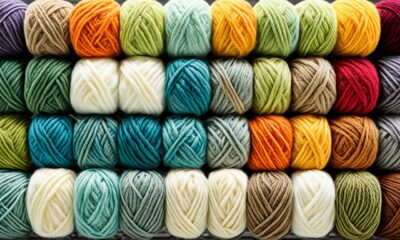Yarn
Best Yarn for Tufting Gun – Top Choices & Tips
Discover the perfect yarn for your tufting gun projects. We guide you on what yarn to use for tufting gun to ensure stunning, durable results.
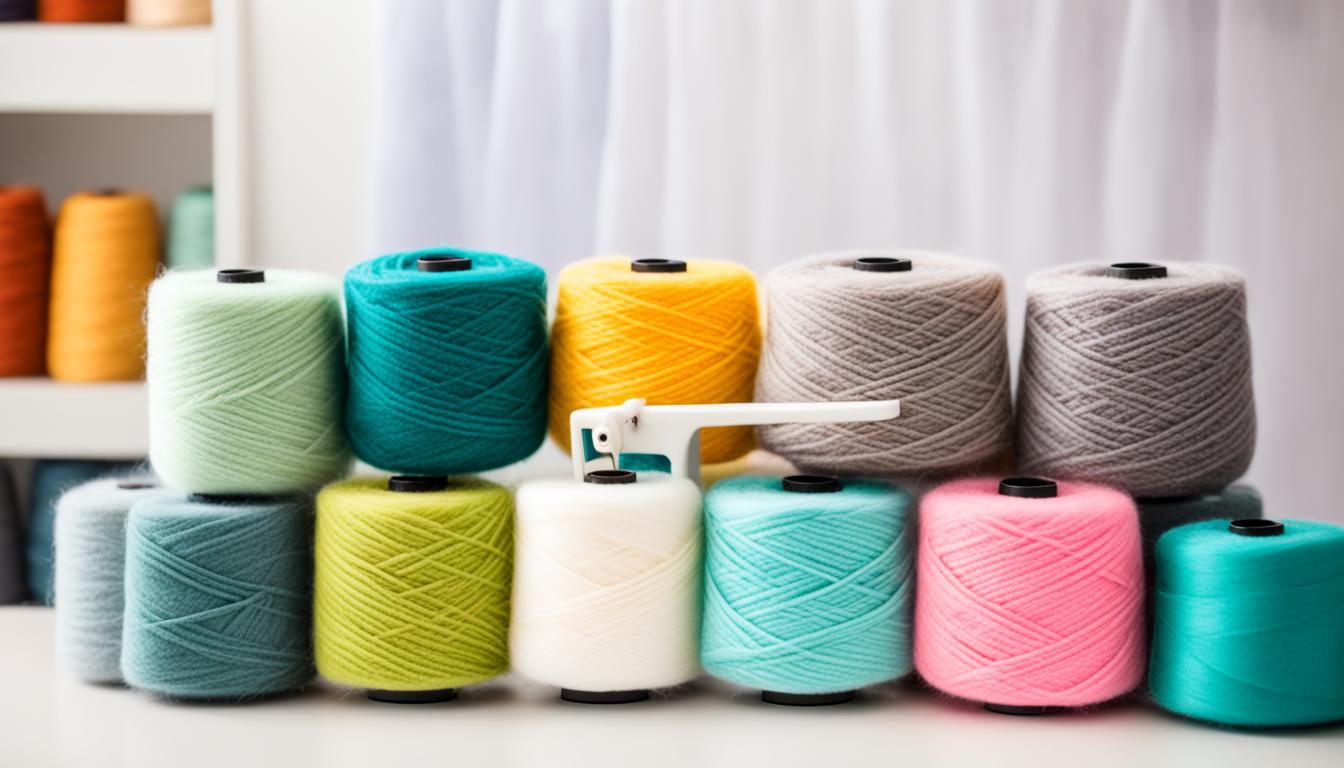
Welcome to our guide on selecting the top yarn for your tufting gun projects! Have you ever puzzled over which yarn is best for your tufting gun or how to achieve incredible results? Don’t worry, we have all the answers. Whether you’re an experienced tufter or a beginner, the yarn you choose is key to making stunning and long-lasting tufted pieces. Let’s delve into the best yarn options and must-know tips to ensure your tufting journey is a triumph!
Key Takeaways:
- Choosing the right yarn is essential for achieving stunning and durable tufted creations.
- Wool, cotton, and acrylic are popular yarn materials for tufting.
- The ply and weight of the yarn play a significant role in tufting gun projects.
- Estimating yarn requirements is important to ensure you have enough for your tufting project.
- Consider the specific qualities and usage requirements when selecting the best yarn for your tufted rugs.
Yarn Material Options for Tufting
When it comes to tufting, you have several yarn material options to choose from. Wool, cotton, and acrylic are commonly used materials for tufting. Each material has its own characteristics and impact on the texture and durability of your tufted object. Consider the qualities of each material to determine the best option for your project.
Wool Yarn
Wool is a popular choice for tufting due to its natural fibers and excellent durability. It provides a soft and luxurious texture and is known for its resilience. Wool yarn is also easy to work with, making it a favorable option for beginners. Additionally, wool has natural insulating properties, making it ideal for creating cozy tufted items such as rugs and blankets.
Cotton Yarn
Cotton yarn is another common choice for tufting projects. It offers a soft and lightweight feel, making it suitable for items like pillows, clothing, and decorative pieces. Cotton is available in a wide range of colors, allowing for endless creative possibilities. However, it’s important to note that cotton yarn may lack the same durability as wool and may not hold its shape as well over time.
Acrylic Yarn
Acrylic yarn is a synthetic alternative that mimics the softness and texture of natural fibers. It is often chosen for its affordability and wide color selection. Acrylic yarn is machine washable and resistant to fading, making it a practical choice for tufted items that require easy maintenance. While acrylic yarn offers versatility, it may not possess the same level of durability as wool or cotton.
Tip: Consider your project’s specific requirements when selecting a yarn material. Take into account factors such as texture, durability, and intended use to ensure the best results.
Experimenting with different yarn materials can lead to unique and beautiful tufted creations. Whether you prefer the natural appeal of wool, the softness of cotton, or the versatility of acrylic, each material has its own charm and qualities to offer. Choose the yarn material that aligns with your vision and enjoy the process of bringing your tufting projects to life.
Choosing the Right Yarn Ply and Weight
When it comes to tufting, selecting the appropriate ply and weight of yarn is essential for achieving the best results with your tufting gun projects. The ply refers to the number of strands twisted together, while the weight refers to the thickness of the yarn. These factors directly impact how the tufting gun needle interacts with the yarn, ensuring a smooth and successful tufting experience.
We recommend opting for yarn that strikes a balance between thickness and maneuverability. It should be thick enough to stay in place once tufted, yet thin enough for the tufting gun needle to easily penetrate without causing any strain or disruptions. Most tufting guns work well with yarn that comprises 2 or 3 strands, providing adequate thickness and stability.
“Finding the right yarn ply and weight is crucial for the success of your tufting gun projects. It ensures that the yarn stays in place while allowing your tufting gun to work smoothly.”
For optimal results, consider using DK/light worsted or aran/worsted weight yarns, known for their versatility and suitability for tufting. These yarn weights strike the perfect balance between thickness and ease of use with tufting guns.
By choosing the right yarn ply and weight, you can create stunning and durable tufting projects that will stand the test of time.
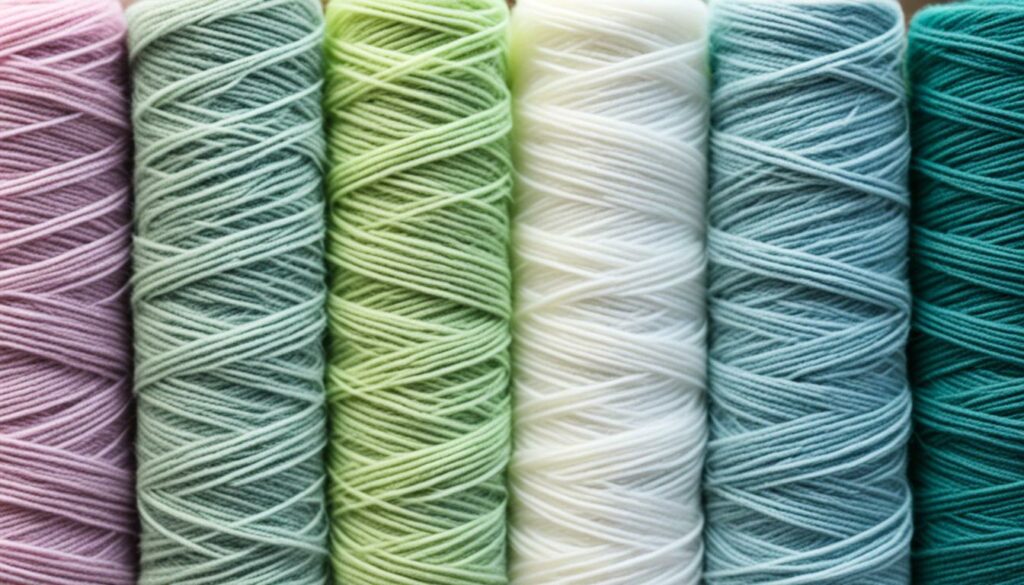
Estimating Yarn Requirements for Tufting
When embarking on a tufting project, it’s essential to estimate the amount of yarn you’ll need. Various factors, such as the project size, pile height, and tufting technique, will influence your yarn requirements. For optimal thickness and stability, it’s recommended to use at least two strands of yarn. To determine the quantity needed:
- Consider the size of the project: A larger project will necessitate more yarn for complete coverage.
- Take into account the specific characteristics of your chosen yarn: Different yarns have varying thicknesses, resulting in different coverage areas per skein.
A useful starting point for estimating yarn requirements is using one 7 oz skein of medium weight yarn. By splitting the skein in half, you can create two strands for tufting approximately one square foot of the project. Bear in mind that this is just a starting point, and actual requirements may vary depending on your specific project and tufting needs.
Tufting Yarn Estimation Example
To illustrate, let’s consider a tufting project for a pillow cover. Assuming the pillow cover is 20 square inches and your chosen yarn requires one 7 oz skein per square foot:
Step 1: Convert square inches to square feet. Divide the total square inches by 144 (the number of square inches in one square foot).
20 square inches ÷ 144 = 0.139 square feet
Step 2: Determine the estimated yarn quantity. Multiply the result from step 1 by the number of strands you plan to use. In this case, we will use two strands.
0.139 square feet × 2 strands = 0.279 skeins of yarn
Therefore, you would need approximately 0.279 skeins of yarn to complete the tufting for the pillow cover.
Remember, this is just an example, and the actual yarn requirement may vary depending on the tufting technique, desired pile height, and other factors specific to your project. Being mindful of these considerations will ensure you have an adequate supply of tufting gun yarn and supplies to complete your tufting project successfully.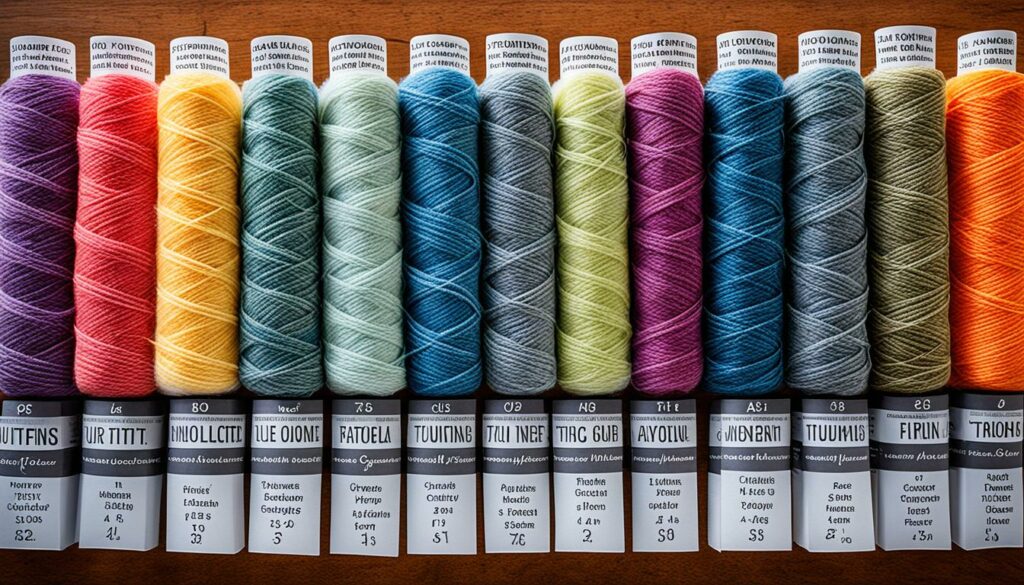
Best Yarn Choices for Tufting
When it comes to tufting, the yarn you choose can greatly impact the final result of your project. To help you make the best decision, we have gathered a list of recommended yarn options for tufting gun projects. Whether you’re a beginner or an experienced tufter, these yarn choices are sure to provide you with the quality and versatility you need.
1. Wool Yarn
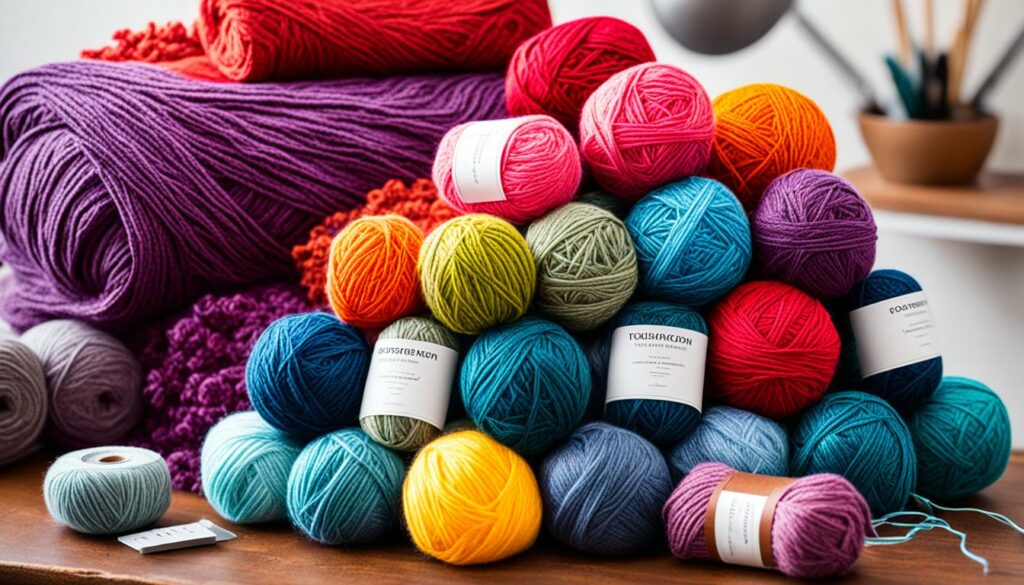
Wool yarn is a popular choice for tufting due to its durability and natural resilience. This type of yarn is known for its ability to hold its shape well, making it suitable for high-traffic areas and rugs. Wool also offers a wide range of color options, allowing you to create beautiful and vibrant tufted designs.
2. Acrylic Yarn
| Advantages | Disadvantages |
|---|---|
| Wide range of colors | Less durable than wool |
| Good affordability | Not resistant to high heat |
| Soft and lightweight | May pill over time |
Acrylic yarn is a synthetic option that offers various advantages for tufting projects. It is available in a wide range of colors, making it easy to find the perfect shade for your design. Acrylic yarn is also more affordable compared to natural fibers like wool. While it may not be as durable as wool, acrylic yarn is soft and lightweight, allowing for comfortable tufted creations.
3. Cotton Yarn
“Cotton yarn is perfect for creating tufted pieces with a soft and plush texture. It provides a natural and breathable feel, making it suitable for use in home decor and wearable items.” – Emily’s Yarn Co.
Cotton yarn is a versatile option for tufting projects, offering a soft and comfortable texture. It is a natural material that is breathable, making it an excellent choice for home decor items and wearables. Cotton yarn comes in a wide variety of colors, allowing you to explore different design possibilities.
4. Chenille Yarn
Chenille yarn is a luxurious option that adds a touch of elegance to your tufted creations. Its velvety texture creates a plush and soft finish, making it ideal for creating cozy rugs, blankets, and pillows. Chenille yarn comes in various colors and is known for its excellent drape and stitch definition.
Whichever yarn option you choose, make sure to consider the specific needs of your tufting project. Take into account factors such as color, durability, and texture to ensure that you achieve the desired results. Happy tufting!
Importance of Yarn Choice in Tufted Rugs
The choice of yarn is crucial in tufted rugs as it greatly affects the comfort and appearance of the final product. While tufted rugs have a simpler structure compared to knotted or woven rugs, the quality of the chosen yarn plays a significant role in their overall aesthetics and durability.
Thicker and stronger yarns are preferred for busy rooms, where foot traffic is high and the rug will experience more wear and tear. These durable yarns can withstand the demands of a busy space, ensuring that the rug maintains its integrity and looks beautiful for years to come. Consider using yarn specifically designed for tufted rugs, which is often thicker and more robust.
On the other hand, for areas with less foot traffic like bedrooms or formal living rooms, softer yarns can add a plush feel and enhance the cozy atmosphere. These soft yarns create a luxurious texture that invites relaxation and comfort. Opt for yarns with a delicate touch that will provide a gentle underfoot experience.
When selecting yarn for tufted rugs, keep in mind both the functionality and aesthetics you desire. The right yarn choice will ensure that your tufted rug not only looks stunning but also withstands the demands of its environment, whether that’s a bustling living room or a serene bedroom.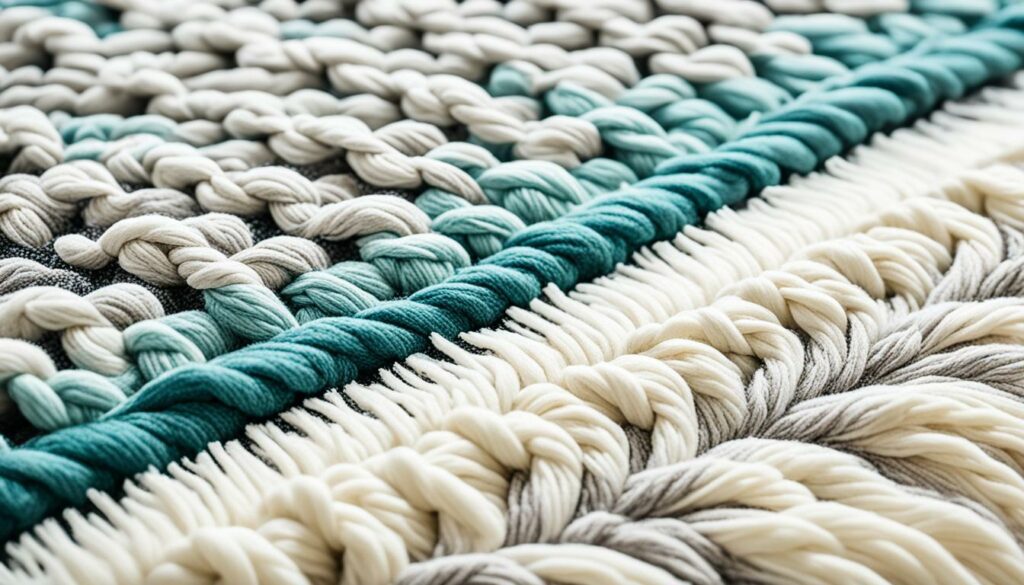
By carefully considering the properties and characteristics of different yarn options, you can ensure that your tufted rugs are not only visually appealing but also durable and comfortable.
Wool Yarn for Tufted Rugs
When it comes to tufted rugs, wool yarn is a popular choice among creators and artisans. Its exceptional durability and quality make it an ideal material for rug tufting projects, particularly in high-traffic areas. Wool is known for its ability to withstand significant wear and tear while maintaining its structural integrity.
One of the advantages of using wool yarn for tufted rugs is its sturdiness. The natural fibers of wool create a strong foundation for tufting, ensuring that the yarn holds up well over time. This strength is especially important for rugs that will be subjected to regular use and foot traffic, as it helps maintain the rug’s shape and prevent unraveling.
Another benefit of using wool yarn is its ease of tufting. With its pliable nature, wool is relatively easy to work with, making it suitable for both beginner and experienced tufters. The yarn’s flexibility allows for smooth and effortless insertion into the rug’s backing, resulting in a more efficient tufting process.
Using wool yarn for tufted rugs provides the added advantage of being able to carve and shear the fibers. This allows tufters to create intricate designs and patterns by manipulating the height and texture of the rug. Whether you want to add dimension or create a luxurious pile, wool yarn offers endless creative possibilities.
When choosing wool yarn for tufted rugs, there are different qualities available in the market. Pure virgin New Zealand wool is often recommended for its exceptional performance and luxurious feel. Other options include blends that incorporate wool with complementary fibers, offering a unique combination of strength and visual appeal.
Overall, wool yarn is a fantastic choice for tufted rugs, providing durability, ease of tufting, and the ability to create intricate designs. Its natural properties make it an ideal material for rug tufting projects, ensuring that your creations will withstand the test of time.
Now that we have explored the benefits of wool yarn, let’s dive into another popular option for tufted rugs: cotton yarn.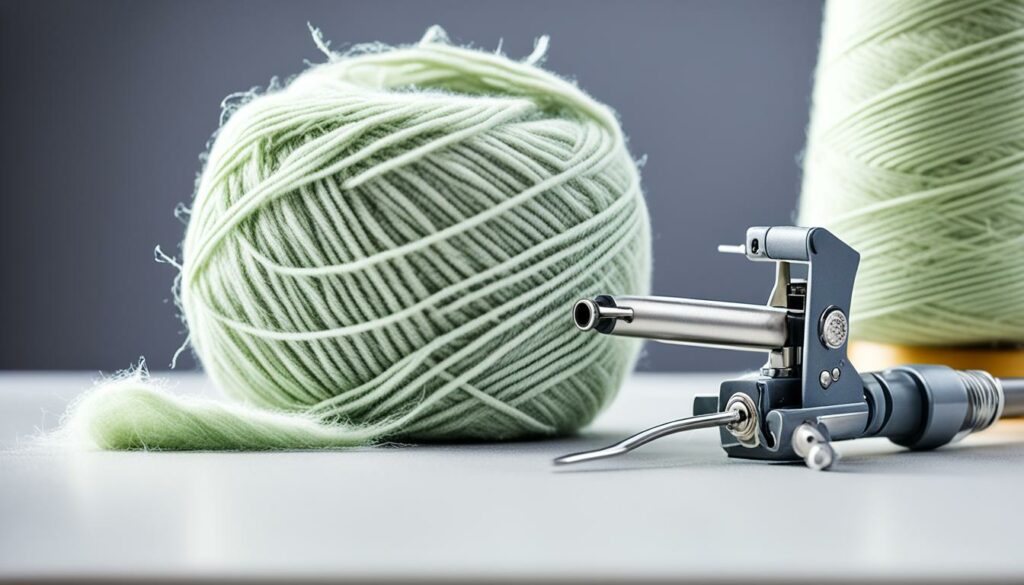
Cotton Yarn for Tufted Rugs
When it comes to tufted rugs, cotton yarn offers a great combination of softness and versatility. As a natural material, it is easy to find in stores and comes in a wide range of colors, making it a popular choice for tufted rugs intended for decorative purposes or wall hangings. The soft feel of cotton adds a cozy touch to any space.
However, it’s important to note that cotton yarn may not be the best option for tufted rugs that require extensive carving or detailing. Due to its limited shearing capabilities, cotton may not hold up as well as other materials in these specific applications. So, if you’re working on a tufted rug project that involves intricate designs or heavy carving, you may want to consider alternative yarn options.
“Cotton yarn is a fantastic choice for adding softness and a touch of natural beauty to your tufted rugs. Its versatility and wide range of colors make it a popular option for decorative pieces. Just be mindful of its limitations when it comes to extensive carving or detailing.” – Jane Smith, Rug Tufting Expert
If you’re unsure about whether cotton yarn is the right choice for your tufted rug project, don’t hesitate to seek advice from experienced tufting professionals or do some experimentation with different yarn materials. Remember, finding the perfect yarn for your tufted rugs will ultimately depend on the specific requirements and desired effects of your project.
Advantages of Cotton Yarn for Tufted Rugs:
- Soft and comfortable feel
- Wide range of colors available
- Natural material
Now that we’ve explored cotton yarn for tufted rugs, let’s move on to discussing the exciting possibilities of using mixed yarns in tufted rug projects.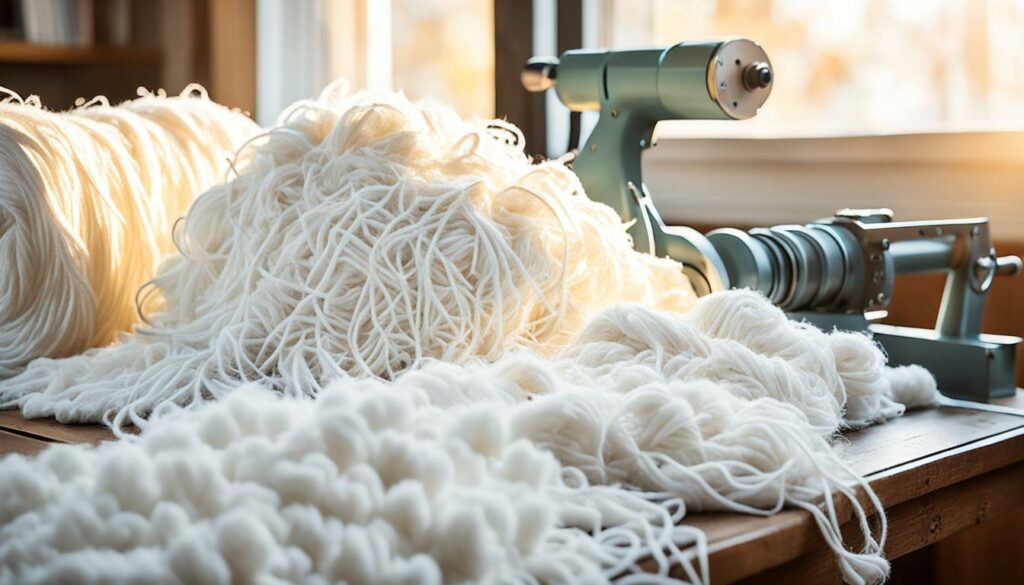
Mixed Yarns for Tufted Rugs
In luxury tufted rugs, we often combine different yarns to achieve specific effects. One popular combination is wool and viscose blends. This blend offers a perfect balance of structure, firmness, and a shiny, soft effect. The wool provides durability and sturdiness, while the viscose adds a touch of sheen and luxurious texture.
When choosing mixed yarns for your tufted rug project, consider the desired qualities and effects you want to achieve. Think about the color palette you have in mind and how the different yarns will interact to create a visually appealing result. Experimentation and creativity play a significant role in tufting, so don’t be afraid to explore different combinations and techniques.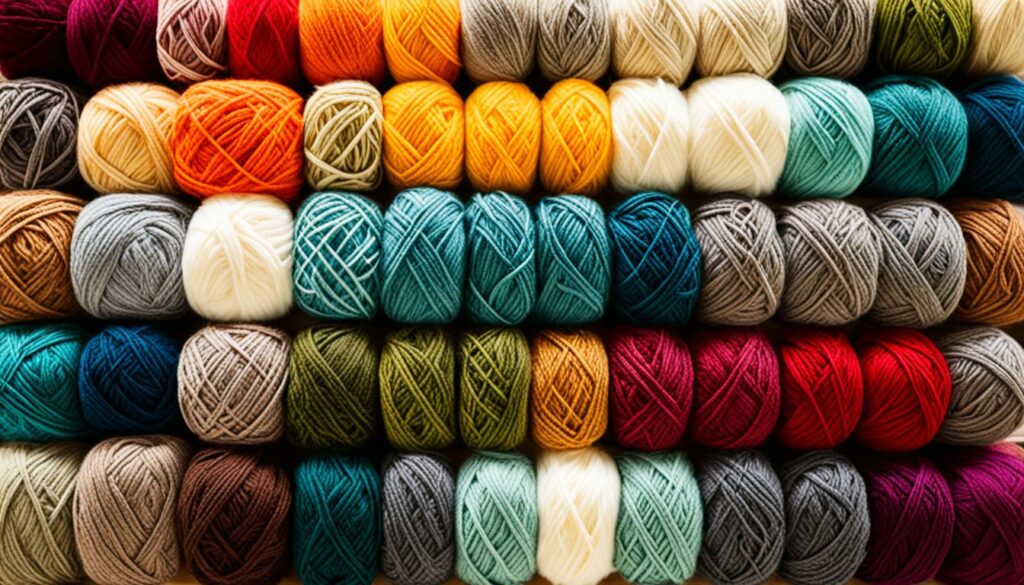
Combining yarns allows for endless possibilities in tufted rug designs. By blending different fibers, colors, and textures, you can create unique patterns and effects that add depth and character to your rugs. The interplay between different materials adds a distinctive touch to your finished piece.
Advantages of Mixed Yarns
Using mixed yarns in tufted rugs offers several advantages:
- Enhanced visual appeal: Different yarns bring variety and depth to the design, creating a more visually interesting rug.
- Improved texture: The combination of yarns can create contrasting textures, adding tactile interest to the rug.
- Greater design flexibility: Mixed yarns open up a wider range of creative possibilities, allowing you to experiment with different patterns and effects.
Considerations for Choosing Mixed Yarns
When selecting mixed yarns for your tufted rug, keep in mind the following considerations:
- Compatibility: Ensure that the yarns you choose work well together and have similar durability and care requirements.
- Color coordination: Consider how the colors of the yarns will interact and complement each other in the final design.
- Texture balance: Experiment with different textures and combinations to achieve the desired balance and effect in your rug.
| Yarn Combination | Effect |
|---|---|
| Wool and viscose blends | Structure, firmness, and shiny, soft effect |
| Wool and cotton blends | Durable with a smoother texture |
| Acrylic and polyester blends | Affordable and resistant to fading |
Considerations for Yarn Choice in Rug Tufting
When it comes to rug tufting, selecting the right yarn is essential for creating a beautiful and durable piece. You’ll need to consider various factors, including the intended use of the rug, the level of traffic in the room, and the size of the rug.
For high-traffic areas, such as hallways or living rooms, wool yarn is often recommended. Wool is known for its durability and ability to withstand heavy use. It can handle the wear and tear that comes with daily foot traffic and is less likely to show signs of wear over time.
Alternatively, if you’re working on a rug for a less busy room, you can opt for softer yarns like cotton. Cotton yarn is comfortable underfoot and adds a cozy touch to your space. It may not be as sturdy as wool, but it is suitable for areas with lighter use.
The size of the rug should also influence your yarn choice. Larger rugs benefit from the durability and thickness of wool yarn. The larger surface area requires a yarn that can hold up to regular use and provide stability.
Overall, the yarn you choose for your rug tufting project should align with your specific needs and preferences. Consider the intended use, traffic level, and rug size to guide your decision-making process. By selecting the right yarn, you’ll ensure that your finished rug is not only visually appealing but also built to withstand the test of time.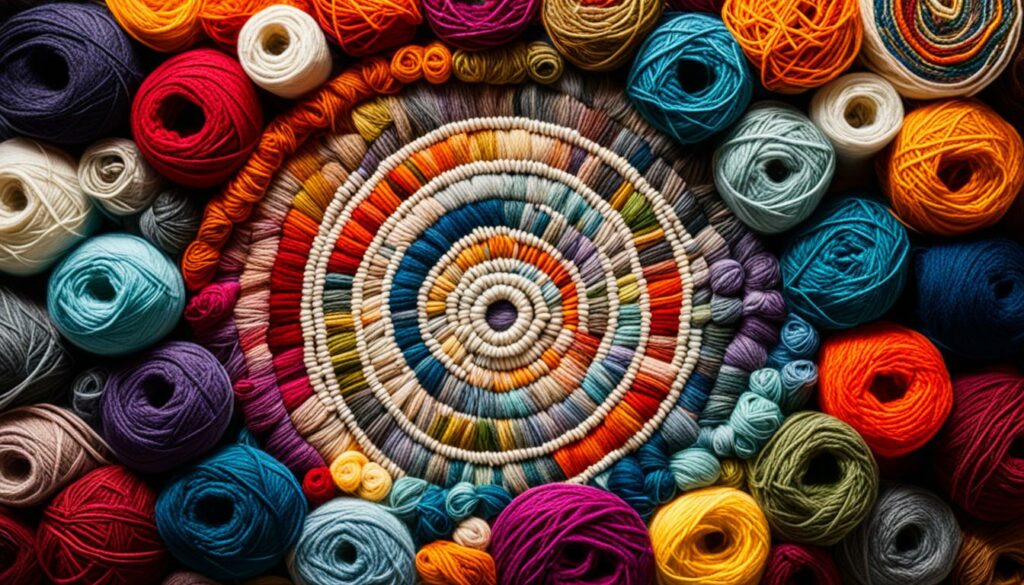
Finding the Perfect Yarn for Your Tufting Gun Projects
Finding the perfect yarn for your tufting gun projects is essential to achieve exceptional results. We understand that selecting the right materials, durability, and desired effects can be overwhelming. That’s why we’re here to guide you through the process and help you make an informed decision. Let’s explore the various options available so that you can create stunning and unique tufted creations.
Explore Different Yarn Options
To find the best yarn for your tufting projects, it’s important to consider materials such as wool, cotton, and acrylic. Each material has its own characteristics, which can significantly impact the final look and feel of your tufted piece. Wool offers durability and texture, while cotton provides softness and versatility. Acrylic, on the other hand, is known for its affordability and vibrant colors. Consider the specific requirements of your project and choose the yarn that best suits your needs.
Experiment for Unique Creations
Don’t be afraid to experiment with different yarns to create truly one-of-a-kind tufted creations. Mixing different materials or combining yarns with varying textures can result in stunning visual effects. Additionally, try incorporating different colors to add depth and dimension to your design. By exploring and pushing the boundaries of traditional tufting, you can create unique pieces that reflect your personal style and vision.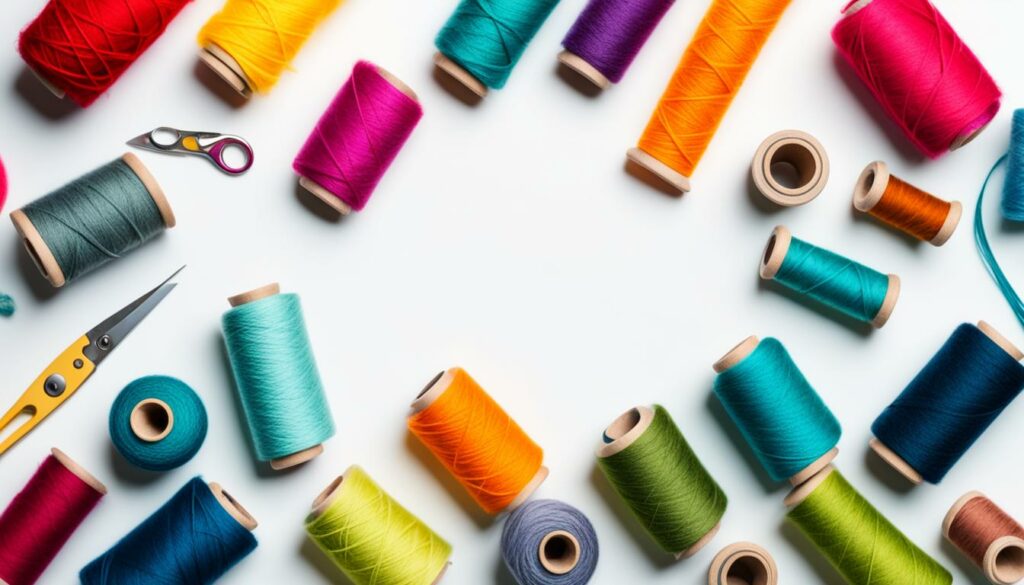
“Choosing the perfect yarn for your tufting gun projects is like setting the foundation for a masterpiece. Take the time to explore different options and embrace the creative possibilities that each yarn brings.”
Consider Durability and Maintenance
While aesthetics are important, durability and maintenance should also be taken into account when choosing yarn for your tufting gun projects. Consider the intended use of your tufted creations; if they will be placed in high-traffic areas, opt for yarns that can withstand frequent use. Additionally, think about the ease of cleaning and maintenance, especially if you’re creating rugs or other items that may require regular care.
Seek Inspiration and Guidance
When in doubt, seek inspiration and guidance from fellow tufting enthusiasts. Join online communities, browse through social media platforms, and explore tufting forums to gather ideas and advice. Collaborating and sharing experiences with others can help you discover new yarn options, techniques, and tips that you may not have considered before. It’s always beneficial to learn from the experiences of others and adapt their knowledge to your own tufting journey.
| Yarn Material | Characteristics | Recommended Projects |
|---|---|---|
| Wool | Durable, textured, easy to work with | Rugs, pillows, wall hangings |
| Cotton | Soft, versatile, wide range of colors | Decorative rugs, wall hangings |
| Acrylic | Affordable, vibrant colors | Decorative items, small projects |
By considering these factors and exploring different yarn options, you can find the perfect yarn for your tufting gun projects. Remember to take into account your project’s specific requirements, experiment, seek inspiration, and embrace the creative possibilities. Happy tufting!
Conclusion
The choice of yarn is a crucial factor in achieving stunning and durable results with your tufting gun projects. When deciding on the perfect yarn, consider the material, ply, weight, and specific requirements of your project. By carefully selecting the best yarn for tufting gun projects, you can ensure a successful tufting experience and create beautiful final products.
Whether you opt for wool, cotton, or a mixed yarn blend, each option has its own unique qualities and advantages. Wool is known for its durability and ability to withstand significant wear, making it an excellent choice for high-traffic areas. Cotton yarn offers softness and versatility, making it suitable for decorative purposes or wall hangings. Mixed yarns can provide unique aesthetic appeal and enhance the overall look of your tufted rugs.
So, before you start your next tufting project, take the time to carefully consider the best yarn for your tufting gun. With the right choice, you’ll achieve stunning results and create tufted masterpieces that will impress everyone. Happy tufting!FAQ
What yarn options are available for tufting?
How do I choose the right yarn ply and weight for tufting?
How much yarn do I need for tufting?
What are some recommended yarn choices for tufting?
What yarn is best for tufted rugs?
Can I use cotton yarn for tufted rugs?
Are there mixed yarn options for tufted rugs?
How does yarn choice affect rug tufting?
How do I find the perfect yarn for my tufting gun projects?
Yarn
Is Yarn Natural or Manmade? Unravel the Truth
Discover if yarn is natural or manmade, explore diverse yarn materials and understand their unique characteristics for your next project.
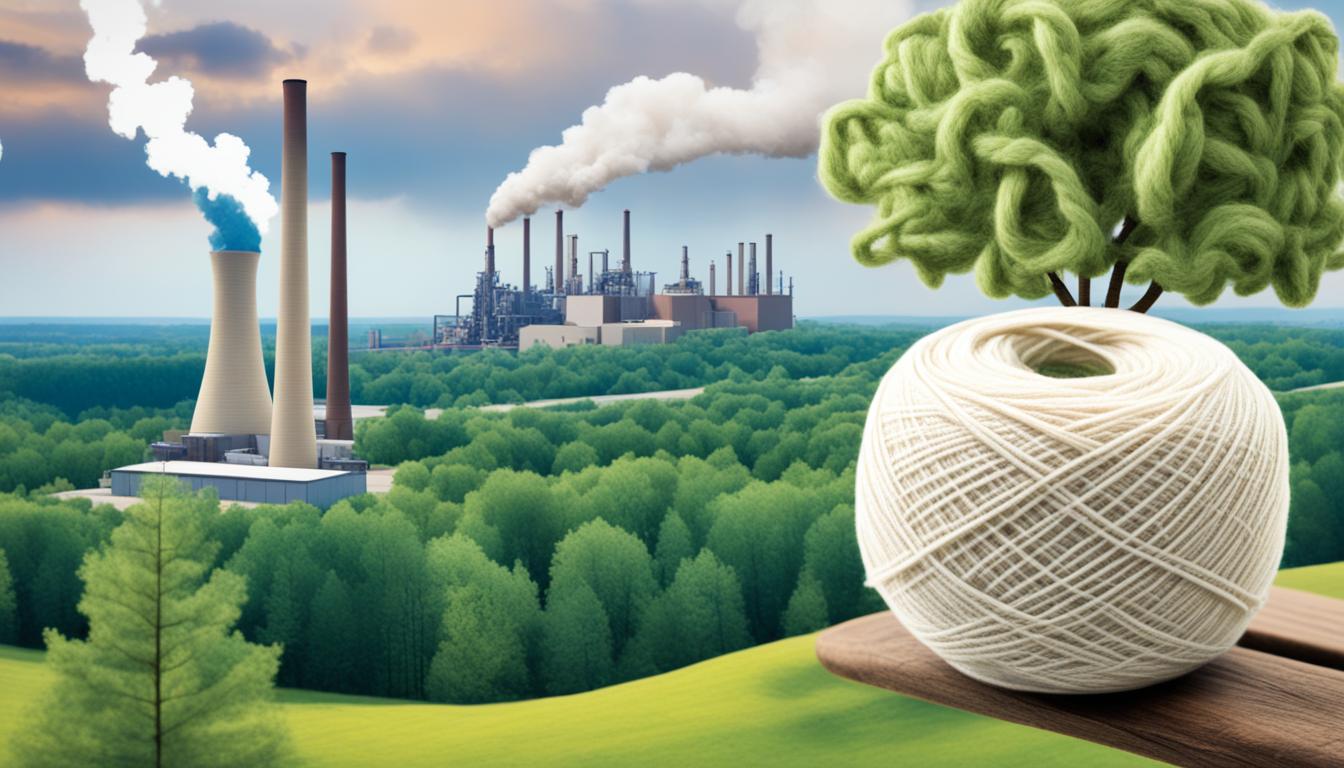
When you imagine yarn, do you envision a warm sweater made from natural fibers or a colorful scarf crafted from synthetic materials? There are different types of yarn, but what sets natural fiber yarn apart from its manmade alternatives? Is one superior to the other? Let’s explore the realm of yarn and discover the realities about its beginnings, qualities, and ideal applications.
Key Takeaways:
- Yarn can be categorized as either natural fiber yarn or synthetic fiber yarn.
- Natural fiber yarn is made from materials that occur in nature, such as cotton, wool, silk, and linen.
- Synthetic fiber yarn is created through chemical processes using materials like acrylic, polyester, and nylon.
- Natural fiber yarn offers breathability, comfort, and a natural aesthetic, while synthetic fiber yarn provides affordability, durability, and versatility.
- Understanding the characteristics and properties of different yarn types can help you make informed crafting decisions.
Understanding Natural Fiber Yarn
Natural fiber yarn is highly regarded for its breathability, durability, and suitability for sensitive skin. The use of natural materials lends these yarns a unique set of characteristics that make them a popular choice among crafters. Let’s explore the different kinds of natural fiber yarn and delve into their production process and distinctive qualities.
Cotton Yarn
Cotton yarn is sought after for its softness, lightweight nature, and exceptional absorbency. It is ideal for warm-weather projects, as it allows for excellent breathability and moisture management. Cotton yarn is derived from the cotton plant, and the fibers are extracted through a series of processes, including shearing, carding, spinning, and dyeing. This yarn holds its shape well and is suitable for a variety of knitting and crocheting projects.
Wool Yarn
Wool yarn is known for its warmth, elasticity, and remarkable moisture-wicking properties. It is an excellent choice for colder climates, as it provides insulation without feeling heavy. Wool yarn is sourced from sheep and other animals, and its production involves similar processes as cotton yarn, such as shearing, carding, spinning, and dyeing. The unique structure of wool fibers allows them to trap air, providing excellent heat retention. Additionally, wool has the ability to regulate body temperature, making it a versatile choice for various projects.
Other Natural Fiber Yarns
In addition to cotton and wool, there are other natural fibers used in yarn production, such as silk and linen. Silk yarn is derived from silk worms and is known for its luxurious feel and lustrous appearance. Linen yarn, made from flax fibers, offers strength, durability, and a crisp texture. Each type of natural fiber yarn has its own set of characteristics, allowing crafters to explore a wide range of options for their projects.
“Natural fiber yarns, such as cotton and wool, possess unique qualities that can enhance your knitting or crocheting projects. From the softness of cotton to the warmth of wool, these yarns offer a delightful crafting experience.”
| Fiber Type | Characteristics |
|---|---|
| Cotton | Soft, lightweight, absorbent |
| Wool | Warm, elastic, moisture-wicking |
| Silk | Luxurious, lustrous |
| Linen | Strong, durable, crisp |
Exploring Synthetic Fiber Yarn
When it comes to choosing yarn for your projects, synthetic fiber yarn offers a wide range of advantages. One of the key benefits is its affordability, making it an excellent choice for budget-conscious crafters. In addition, synthetic fiber yarn is known for its versatility, as it can easily mimic the characteristics of various natural fibers such as cotton or wool. Whether you’re looking for softness, durability, or resistance to stretching, there’s a synthetic fiber yarn that fits your needs.
What sets synthetic fiber yarn apart is its engineered nature. Through a process known as yarn production, synthetic fibers are chemically created to exhibit specific characteristics. For example, acrylic yarn is known for its softness and lightweight feel, while polyester yarn offers excellent durability and resistance to wrinkles and stretching. This enables crafters to achieve consistent and reliable results in their projects.
The production of synthetic fiber yarn involves careful chemical processes like polymerization and extrusion. As a result, synthetic fibers are created with consistent properties, from the colorfastness to the strength and resistance to shrinkage. This ensures that synthetic fiber yarn can withstand the wear and tear of frequent use and maintain its shape and integrity over time.
When considering synthetic fiber yarn, it’s important to weigh the characteristics and advantages it offers. Take a look at the table below for a comparison of different synthetic fiber yarn types:
| Yarn Type | Characteristics |
|---|---|
| Acrylic Yarn | Soft, lightweight, and affordable |
| Polyester Yarn | Durable, resistant to stretching, and colorfast |
| Nylon Yarn | Strong, lightweight, and quick-drying |
As you can see, each type of synthetic fiber yarn has its own unique qualities that cater to different project requirements. Whether you’re creating cozy sweaters, durable blankets, or vibrant accessories, synthetic fiber yarn offers a multitude of options to bring your creative vision to life.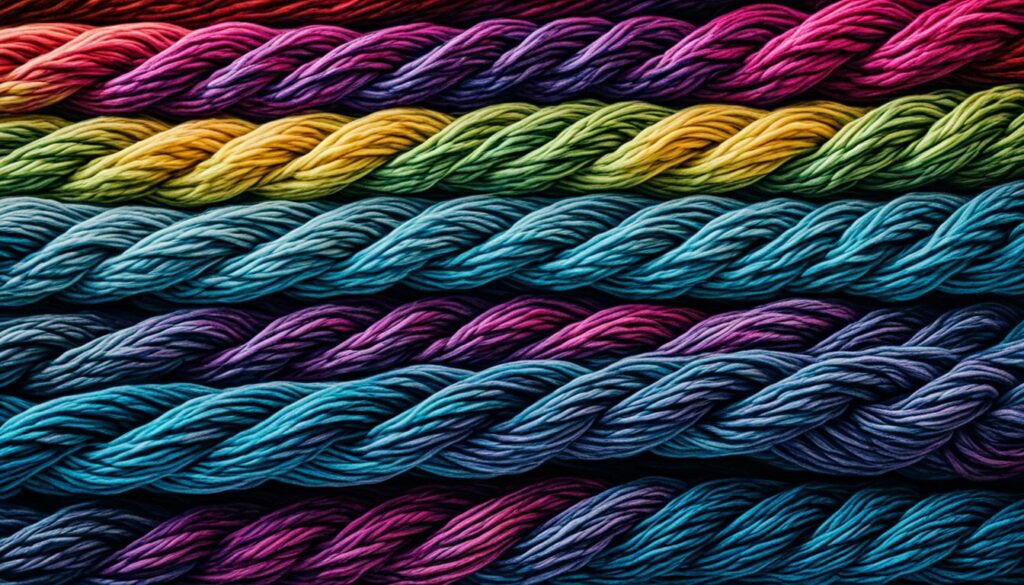
Infographic: Synthetic Fiber Yarn Characteristics
For a quick reference, here’s an infographic highlighting the characteristics of synthetic fiber yarn: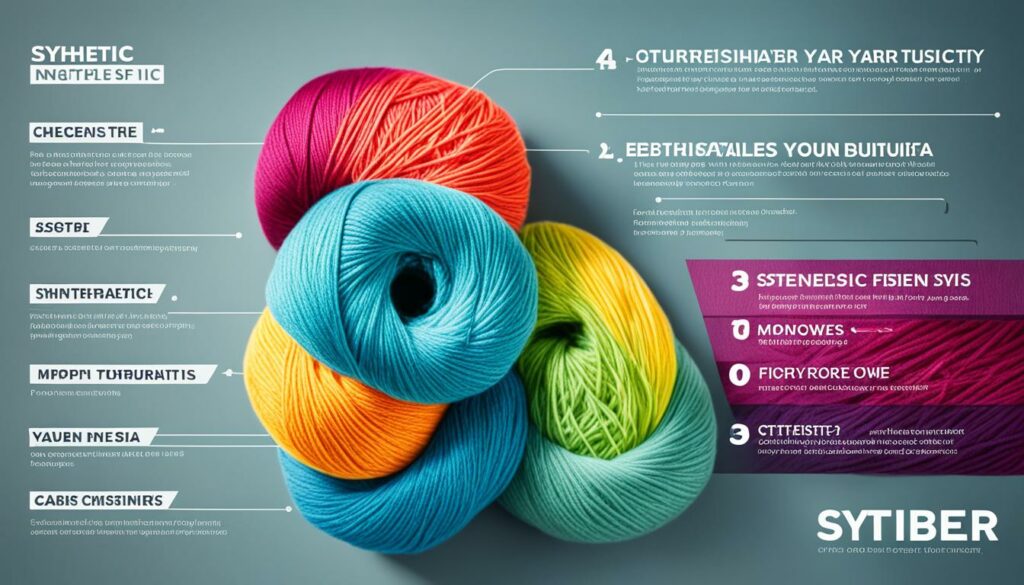
With synthetic fiber yarn’s affordability, versatility, and durability, it’s no wonder that it has become a popular choice among crafters. Whether you’re a beginner or an experienced yarn enthusiast, synthetic fiber yarn offers a world of creative possibilities.
Identifying Natural and Manmade Yarn
When choosing yarn for your next project, it’s important to be able to distinguish between natural and manmade yarn. One simple method for identifying the type of yarn is through a burn test. Natural fiber yarn, such as cotton or wool, will behave differently when burned compared to synthetic fiber yarn, like acrylic or polyester.
During a burn test, natural fibers will burn slowly and curl away from the flame. They may also leave behind a lingering smell similar to burning hair. On the other hand, synthetic fibers tend to burn more quickly and may melt or shrink. You may notice a distinct odor similar to burning plastic.
Characteristics of Natural and Synthetic Yarn
Natural fiber yarns have distinct characteristics that differentiate them from synthetic yarns. They often have a specific feel and appearance, with subtle variations in texture and sheen. Natural fiber yarns, like cotton and wool, may have slight imperfections and irregularities that add to their charm.
Synthetic fiber yarns, on the other hand, tend to have a more uniform texture and sheen. They are often created through chemical processes, resulting in fibers with consistent properties. Synthetic yarns can offer a wide range of colors and textures, making them ideal for projects that require specific aesthetics.
In a burn test, natural fiber yarn will burn slowly and curl away from the flame, while synthetic fiber yarn will burn more quickly and may shrink or melt. Natural fiber yarns have a unique feel and appearance, while synthetic fiber yarns often have a more uniform texture and sheen.
The production process for natural and synthetic yarn also differs. Natural fiber yarn is typically made from plant or animal materials that undergo processes like shearing, carding, spinning, and dyeing. These processes preserve the inherent qualities of the fibers and result in yarn with unique properties.
On the other hand, synthetic fiber yarn is produced through chemical processes like polymerization and extrusion. These processes allow for the creation of fibers with desired characteristics, such as strength, colorfastness, and resistance to wrinkles and shrinkage.
Comparison of Natural and Synthetic Yarn
| Natural Yarn | Synthetic Yarn |
|---|---|
| Derived from plant or animal materials | Created through chemical processes |
| Unique feel and appearance | Uniform texture and sheen |
| Subject to natural variations and imperfections | Consistent properties and colors |
| Generally biodegradable and renewable | Not biodegradable and made from non-renewable resources |

Understanding the differences between natural and synthetic yarn can help you make informed decisions when selecting yarn for your projects. Whether you prefer the unique qualities of natural fiber yarn or the versatility of synthetic fiber yarn, each type has its own set of characteristics and benefits. Consider your project requirements and personal preferences to find the perfect yarn for your next knitting or crocheting adventure.
The Benefits of Natural Fiber Yarn
Natural fiber yarn offers several benefits that make it a popular choice for crafters and fashion enthusiasts alike. Whether you’re knitting a cozy sweater or creating intricate crochet designs, here are some reasons why natural fiber yarn should be on your radar.
Biodegradable and Sustainable
Natural fiber yarn is biodegradable, meaning it can decompose over time without leaving behind harmful waste. Unlike synthetic fibers that contribute to plastic pollution, natural fiber yarns provide an eco-friendly alternative. By choosing natural fiber yarn, you’re making a sustainable choice and reducing your environmental impact.
Breathable and Comfortable
One of the standout characteristics of natural fiber yarn is its breathability. Yarns made from cotton, wool, silk, and other natural materials allow air to circulate, helping to regulate body temperature and keeping you comfortable in any season. The breathability of natural fiber yarns also makes them ideal for projects like lightweight summer garments.
Moisture-Wicking Properties
Natural fiber yarns have inherent moisture-wicking properties, meaning they can absorb moisture and draw it away from the skin. This feature makes natural fiber yarn perfect for creating cozy activewear, socks, or other items that come into contact with sweat. With natural fiber yarn, you can stay dry and comfortable during physical activities.
Unique Texture and Aesthetic
Each natural fiber presents its own unique texture and aesthetic appeal. Cotton yarn offers a soft and smooth feel, while wool yarn provides warmth, elasticity, and a cozy touch. The rich and luxurious look of silk yarn adds elegance to any project, while linen yarn offers a rustic and textured appearance. These distinct characteristics allow you to experiment with different yarns to achieve desired textures and appearances in your creations.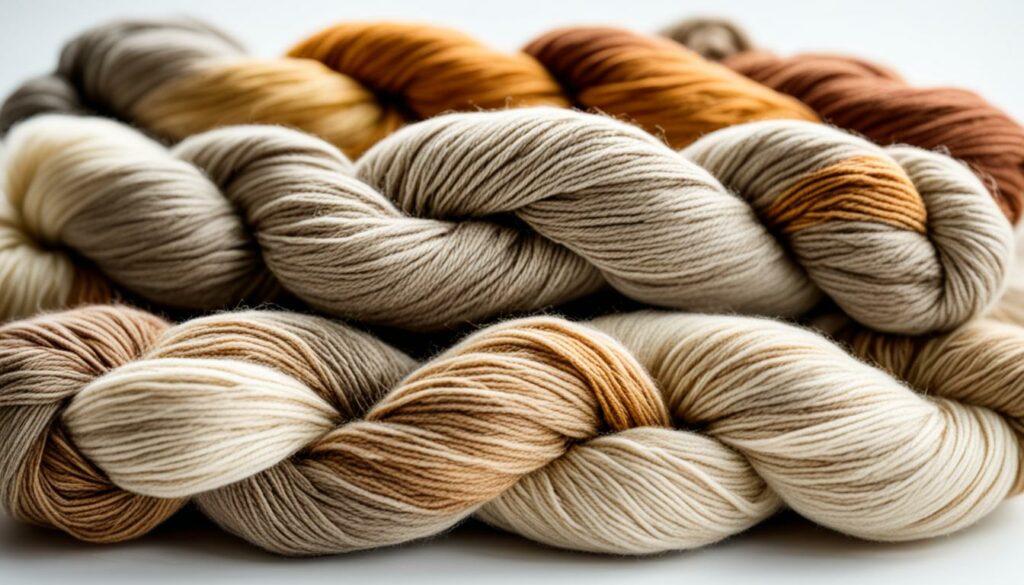
As you can see, natural fiber yarn brings numerous benefits to your projects. Not only is it sustainable and comfortable, but it also offers a wide range of unique textures and aesthetics. By incorporating natural fiber yarn into your knitting and crocheting, you can create beautiful, eco-friendly pieces that are as enjoyable to make as they are to wear.
The Advantages of Synthetic Fiber Yarn
Synthetic fiber yarn offers several advantages that make it a popular choice for various projects. Whether you’re a knitting enthusiast or a crochet lover, synthetic fiber yarn can be a versatile and practical option. Here are some key benefits of using synthetic fiber yarn:
- Affordability: Synthetic fiber yarn is often more budget-friendly compared to natural fiber yarn. This makes it a great choice for crafters who want to create beautiful projects without breaking the bank.
- Wide range of colors and textures: Synthetic fiber yarn is available in an extensive array of vibrant colors and textures. Whether you prefer a bold and eye-catching design or a subtle and soft texture, there’s a synthetic fiber yarn that suits your creative vision.
- Low maintenance: One of the advantages of synthetic fiber yarn is its resistance to wrinkles, shrinking, and fading. This makes it highly suitable for projects that require minimal care and can withstand regular use and washing.
- Allergy-friendly: For individuals with allergies to natural fibers like wool or silk, synthetic fiber yarn can be a great alternative. It doesn’t trigger common allergies and provides a comfortable crafting experience without any discomfort or irritation.
If you’re looking for an affordable, vibrant, and low-maintenance yarn option, synthetic fiber yarn is an excellent choice. Its wide range of colors and textures, coupled with its allergy-friendly nature, make it a go-to choice for many crafters. Experimenting with synthetic fiber yarn can add a unique touch to your projects and help you achieve stunning results.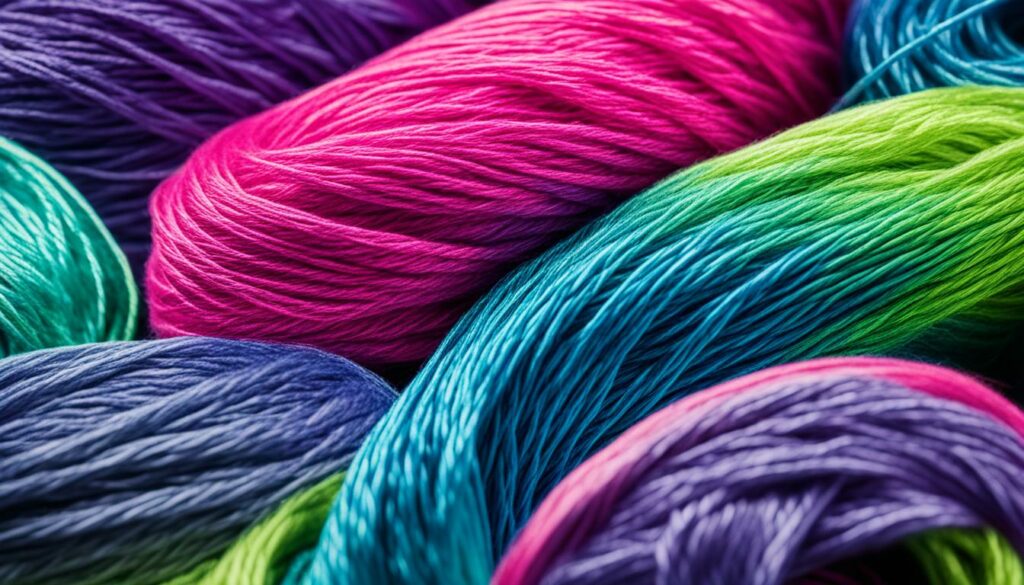
Choosing the Right Yarn for Your Project
When it comes to selecting yarn for your project, it’s important to consider the specific characteristics required for the item you are creating. Both natural fiber yarn and synthetic fiber yarn have unique qualities that make them suitable for different types of projects.
Natural fiber yarn is an excellent choice for garments, accessories, and items that come into direct contact with the skin. It offers breathability, comfort, and a natural aesthetic. Natural fiber yarn is made from materials like cotton, wool, silk, and linen, which are derived from nature. These yarns have a soft feel and can provide warmth or maintain coolness, depending on the type of fiber used. They are also known for their absorbency and ability to regulate body temperature. Natural fiber yarn is produced through processes like shearing, carding, spinning, and dyeing, preserving the inherent qualities of the fibers.
“`html
Natural fiber yarn is suitable for:
- Garments
- Accessories
- Items in direct contact with the skin
“`
Synthetic fiber yarn, on the other hand, is often preferred for items that need to retain their shape and durability. If you’re making blankets or outdoor gear, synthetic fiber yarn is a great option. Synthetic fibers like acrylic, polyester, and nylon are engineered through chemical processes to have specific characteristics such as strength, colorfastness, and resistance to wrinkles and shrinkage. Acrylic yarn, for instance, is known for its softness and affordability, while polyester yarn is durable and resistant to stretching. Synthetic fiber yarn is produced through processes like polymerization and extrusion, resulting in fibers with consistent properties.
“`html
Synthetic fiber yarn is suitable for:
- Blankets
- Outdoor gear
- Items requiring shape retention and durability
“`
When choosing the right yarn for your project, don’t be afraid to experiment with different types. Each type of yarn offers its own unique set of qualities and benefits. By understanding the characteristics of both natural and synthetic fiber yarns, you can make informed decisions and create beautiful, functional items that suit your needs.
Next, let’s explore some tips for working with natural and synthetic yarn to ensure successful projects.
Tips for Working with Natural and Synthetic Yarn
Working with yarn can be a delightful and creative experience, whether you’re using natural fiber yarn or synthetic fiber yarn. Each type of yarn has its own unique characteristics and requires a slightly different approach. Here are some useful tips to help you make the most of your knitting or crocheting projects:
Working with Natural Fiber Yarn
When working with natural fiber yarn, it’s important to take into account its inherent qualities and properties. Here are some tips to keep in mind:
- Pay attention to blocking: Natural fiber yarn has memory, which means it can easily be shaped. This makes it important to block your finished projects to ensure that they maintain their desired shape. Blocking involves gently shaping your project by wetting or steaming it and allowing it to dry in the desired shape.
- Handle with care: Natural fiber yarn, such as cotton, wool, silk, or linen, can be more delicate compared to synthetic yarn. Take care when handling, as it can potentially shrink or felt if exposed to high temperatures or harsh agitation. Follow the washing instructions provided on the yarn label to ensure proper care.
- Consider fiber-specific techniques: Different natural fiber yarns may require specific techniques. For example, wool yarn benefits from gentle blocking with water, while linen yarn typically benefits from steam blocking.
Working with Synthetic Fiber Yarn
Synthetic fiber yarns, such as those made from acrylic, polyester, or nylon, offer their own set of advantages. Here are some tips to keep in mind when working with synthetic fiber yarn:
- Be mindful of blocking: Synthetic fiber yarn is generally less likely to shrink compared to natural fiber yarn. However, it may not hold blocking as well. Keep this in mind when shaping your projects and consider alternative blocking methods.
- Be aware of static electricity: Synthetic fiber yarn can be more prone to static electricity, which can be noticeable when wearing or working with the yarn. Consider using anti-static sprays or fabric softeners to help reduce static.
- Experiment with different stitches: Synthetic fiber yarns often have a more uniform texture and can be forgiving when it comes to stitch mistakes. This makes it a great option for trying out new stitches or patterns.
Remember, regardless of the type of yarn you choose, experimenting with different techniques and learning from your experiences will help you become more comfortable and skilled in working with yarn. Don’t be afraid to try new things and let your creativity flow!
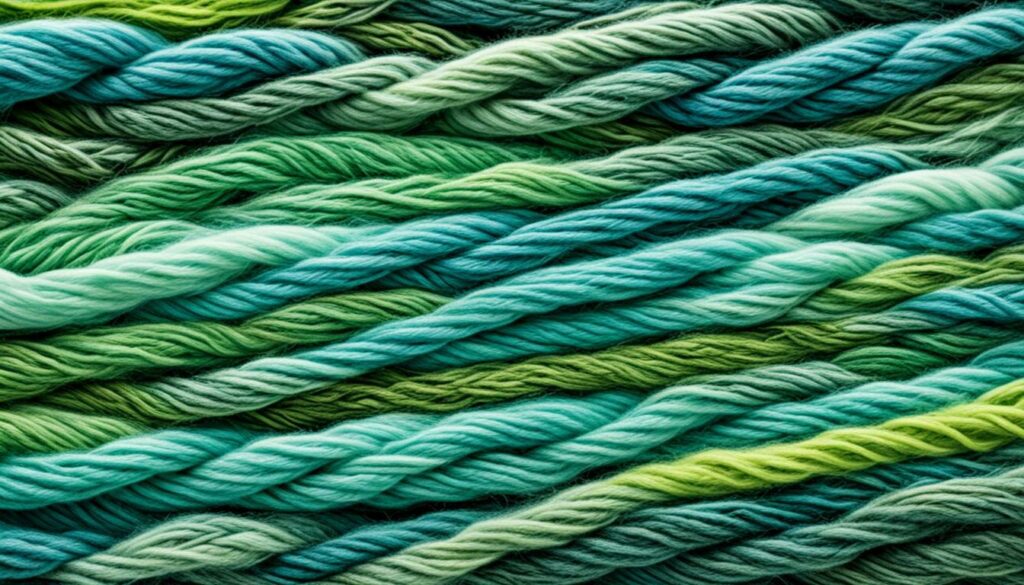
| Working with Natural Fiber Yarn | Working with Synthetic Fiber Yarn |
|---|---|
| Natural fiber yarn has memory and can easily be shaped. Pay attention to blocking and gently shape your projects to maintain their desired shape. | Synthetic fiber yarn is less likely to shrink, but it may not hold blocking as well. Be mindful of the blocking techniques you use. |
| Natural fiber yarn can shrink or felt if not handled properly. Follow the washing instructions on the yarn label to ensure proper care. | Synthetic fiber yarn can be more prone to static electricity. Use anti-static sprays or fabric softeners to reduce static. |
| Consider fiber-specific techniques for different natural fiber yarns. For example, wool benefits from gentle blocking with water, while linen yarn typically benefits from steam blocking. | Synthetic fiber yarn often has a more forgiving nature and can be great for experimenting with different stitches and patterns. |
Caring for Natural and Synthetic Yarn
Proper care and maintenance are essential for keeping your natural fiber yarn and synthetic fiber yarn in top condition. By following a few simple guidelines, you can ensure that your yarn retains its quality and lasts for years to come.
Caring for Natural Fiber Yarn
Natural fiber yarn, such as cotton, wool, silk, and linen, requires gentle washing and special attention. Here are some tips for caring for your natural fiber yarn:
- Washing: Hand wash natural fiber yarn using a mild detergent in cool water.
- Drying: After washing, reshape the garment or item made from natural fiber yarn and lay it flat to dry. This helps maintain the shape and prevent stretching.
- Storage: Store natural fiber yarn in a cool, dry place to prevent damage from moths or humidity. Avoid storing it in plastic bags, as these can trap moisture.
By following these care instructions, you can keep your natural fiber yarn looking and feeling its best.
Caring for Synthetic Fiber Yarn
Synthetic fiber yarn, such as acrylic, polyester, and nylon, is generally easier to care for and more durable. Here are some tips for caring for your synthetic fiber yarn:
- Washing: Synthetic fiber yarn can usually withstand machine washing. Follow the care instructions on the yarn label.
- Drying: Synthetic fiber yarn can be dried in a machine dryer, but it’s best to use low heat or air dry to prevent excessive pilling.
- Pilling: Over time, synthetic fiber yarn may develop small fiber balls called pills. You can remove pills using a fabric shaver or carefully snipping them off with sharp scissors.
With proper care, your synthetic fiber yarn will remain soft, vibrant, and resistant to wear and tear.
Remember, whether you’re working with natural fiber yarn or synthetic fiber yarn, it’s important to read the care instructions on the yarn label and consider any specific recommendations from the yarn manufacturer.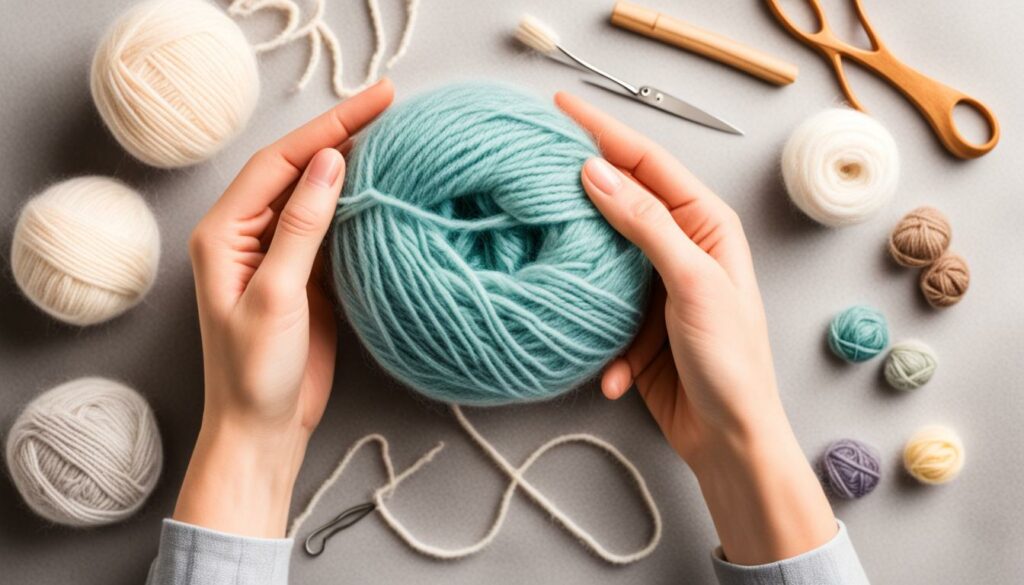
Following these care guidelines will help you keep your yarn in excellent condition, ensuring that you can enjoy your knitting or crocheting projects for years to come.
Exploring Yarn Sustainability
When it comes to sustainability, choosing the right yarn materials is crucial. Natural fiber yarn, such as cotton and wool, is often considered more eco-friendly due to its biodegradability and renewable sources. These yarns are derived from plants and animals, making them a sustainable choice for those concerned about the environment.
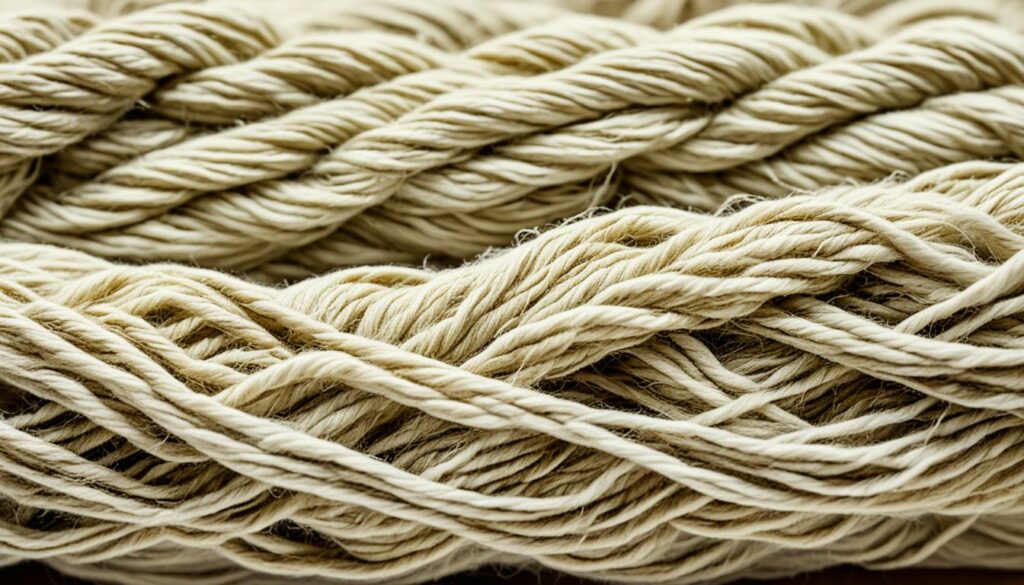
However, synthetic fiber yarn can also contribute to sustainability efforts. Many synthetic yarns are made from recycled materials, reducing waste and decreasing the demand for new resources. Additionally, advancements in manufacturing processes have enabled the production of synthetic fibers in a more sustainable manner.
When making sustainable choices, consider the environmental impact of the materials used in the production of yarn. Take into account factors such as the energy consumption, water usage, and chemical treatments involved in the manufacturing process. Look for certifications or labels that indicate environmentally friendly practices, such as organic or recycled materials.
Another consideration is the lifespan and recyclability of the yarn. Natural fiber yarns, although biodegradable, may have a shorter lifespan than synthetic fiber yarns. However, they can easily decompose and return to the earth, minimizing their impact on the environment. On the other hand, synthetic fiber yarns can be recycled and made into new products, extending their lifespan and reducing waste.
“The choices we make in our crafting projects can have a positive impact on the environment. By opting for sustainable yarn materials, we contribute to the conservation of natural resources and reduce our carbon footprint.”
| Yarn Type | Benefits | Considerations |
|---|---|---|
| Natural Fiber Yarn | – Biodegradable | – Shorter lifespan |
| Synthetic Fiber Yarn | – Made from recycled materials | – Long lifespan |
Ultimately, the choice between natural fiber yarn and synthetic fiber yarn depends on your project’s specific requirements and your own sustainability goals. By being mindful of the materials used in crafting, we can contribute to a greener future and enjoy our creative endeavors guilt-free.
The Future of Yarn Innovation
The yarn industry is constantly evolving, driven by advancements in technology and a growing focus on sustainability. Exciting developments in yarn production, materials, and types are shaping the future of this beloved craft. Let’s explore some of the innovative trends that are revolutionizing the world of yarn.
Recycled Yarns: Eco-Friendly and Stylish
Recycled yarns are gaining popularity as a sustainable alternative to traditional yarn materials. These yarns are made from post-consumer or post-industrial waste, such as plastic bottles or textile remnants, that are transformed into new fibers. By diverting waste from landfills, recycled yarns contribute to a circular economy and reduce the environmental impact of yarn production. Additionally, these eco-friendly yarns come in a variety of colors and textures, allowing crafters to create beautiful and unique projects.
Plant-Based Synthetics: Nature-Inspired Yarns
Plant-based synthetic yarns are another exciting innovation in the world of yarn. These yarns are derived from renewable sources such as bamboo, hemp, or corn. They offer the benefits of synthetic fiber yarns, such as durability and easy care, while also providing a more sustainable option. Plant-based synthetics can be blended with natural fibers or used on their own, offering versatile options for various projects. Crafters can enjoy the performance of synthetic yarns while minimizing their environmental footprint.
Biodegradable Fibers: Sustainable and Earth-Friendly
Biodegradable fibers are revolutionizing the yarn industry and addressing the issue of microplastic pollution. These fibers are designed to break down naturally over time, reducing their impact on the environment. Materials such as lyocell and hemp are known for their biodegradability, as they can be composted or decomposed without releasing harmful toxins. Crafters who prioritize sustainability can now choose biodegradable yarns to create beautiful projects while minimizing their ecological impact.
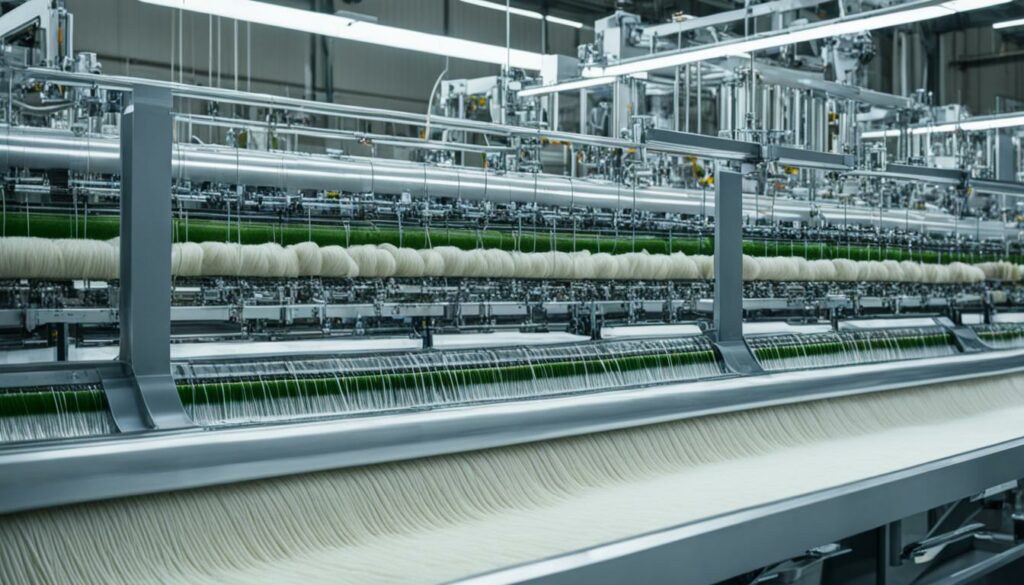
With these innovative advancements in yarn production, materials, and types, the future of yarn is brighter than ever. Crafters now have access to a wide range of sustainable and performance-driven options. Whether you prefer recycled yarns, plant-based synthetics, or biodegradable fibers, there are exciting choices for every project.
Comparison Table: Yarn Innovations at a Glance
| Yarn Innovation | Benefits |
|---|---|
| Recycled Yarns | – Sustainable – Wide range of colors and textures – Reduces waste |
| Plant-Based Synthetics | – Renewable – Durable and easy care – Nature-inspired fibers |
| Biodegradable Fibers | – Sustainable – Minimizes microplastic pollution – Compostable or decomposable |
As the yarn industry continues to innovate, new possibilities emerge for crafters seeking sustainable and performance-driven options. Stay tuned for exciting developments in yarn production, as well as advancements in materials and types that can inspire and enhance your future projects.
Conclusion
When it comes to choosing yarn for your knitting or crocheting projects, you have the option of natural fiber yarn or synthetic fiber yarn. Natural fiber yarn, made from materials like cotton, wool, silk, and linen, offers breathability, comfort, and a natural aesthetic. On the other hand, synthetic fiber yarn, created using materials like acrylic, polyester, and nylon, provides affordability, durability, and versatility.
Understanding the characteristics and properties of different yarn types is crucial in making informed decisions. Natural fiber yarn is known for its breathability, durability, and suitability for sensitive skin. It is produced through processes like shearing, carding, spinning, and dyeing, preserving the inherent qualities of the fibers. Synthetic fiber yarn, on the other hand, is engineered to have specific characteristics like strength and colorfastness. It is created through chemical processes like polymerization and extrusion, resulting in fibers with consistent properties.
Whether you prioritize the breathability and natural appeal of natural fiber yarn or the affordability and versatility of synthetic fiber yarn, both options have their own unique qualities and benefits. So the next time you embark on a knitting or crocheting project, consider the yarn materials and their production processes to ensure you choose the most suitable yarn. Happy crafting!FAQ
Is yarn natural or manmade?
What materials are used to make yarn?
What are the differences between natural and manmade yarn?
What are the characteristics of natural fiber yarn?
What are the characteristics of synthetic fiber yarn?
How can I identify whether a yarn is natural or manmade?
What are the benefits of natural fiber yarn?
What are the advantages of synthetic fiber yarn?
How do I choose the right yarn for my project?
Any tips for working with natural and synthetic yarn?
How do I care for natural and synthetic yarn?
What are the sustainability considerations for yarn?
What is the future of yarn innovation?
Vivienne – Your Content Companion Vivienne is your content companion, curating valuable tips, advice, and inspiration to guide you on your home decor journey. From insightful blog posts to informative product descriptions, she’s here to empower you with the knowledge you need to create your dream space.
Yarn
Unraveling the Cost: Why Does Yarn Cost So Much?
Explore the complexities behind high yarn prices and learn why yarn costs so much. Dive into yarn pricing factors with us!
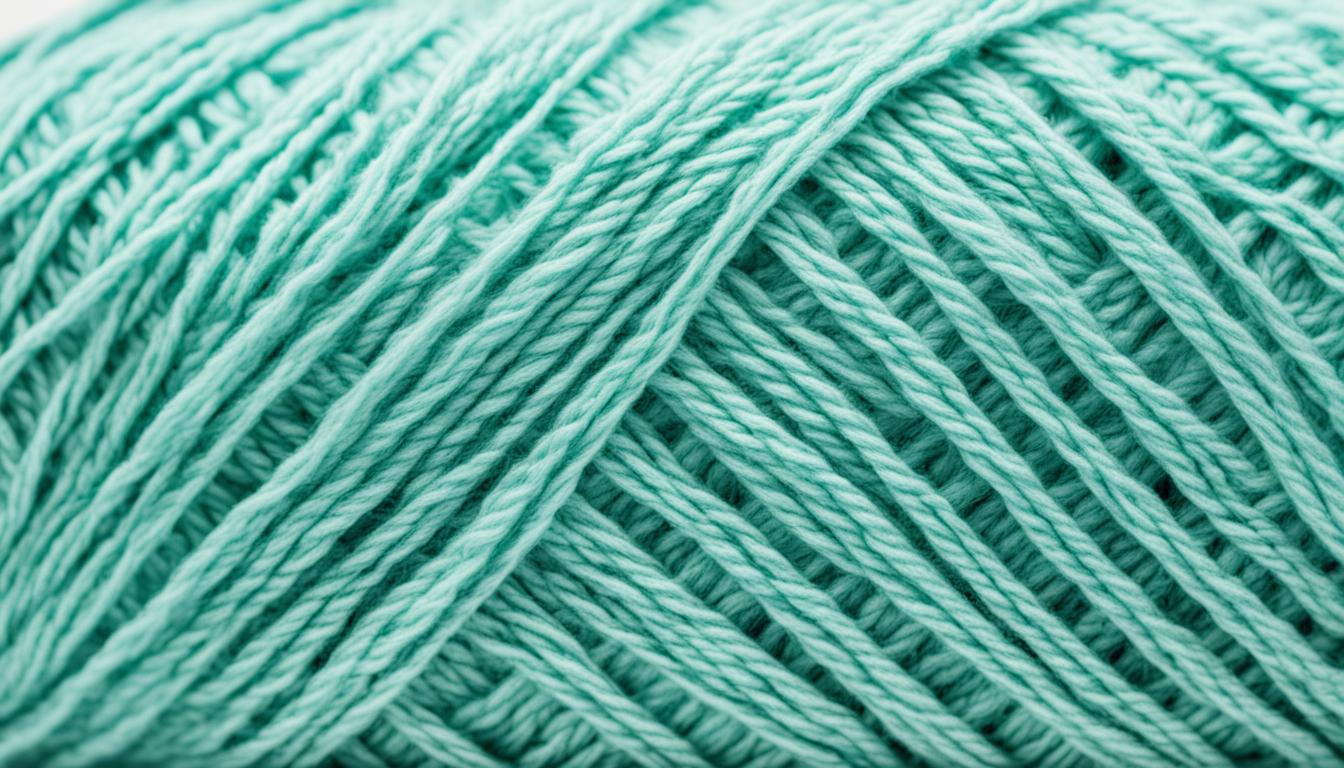
Have you ever pondered why yarn often carries a high price tag? Whether you’re a devoted knitter or simply appreciate the comfort of a handmade sweater, it’s important to comprehend the reasons behind yarn pricing. Factors such as material costs and the effects of inflation play a significant role in unraveling the mystery of why yarn can be expensive.
In this article, we will delve into the factors that influence yarn prices, providing insights into the yarn industry’s pricing dynamics. By unraveling the cost, we aim to shed light on why yarn comes with a higher price compared to other materials and challenge common beliefs surrounding the price of yarn.
Key Takeaways:
- Understanding the factors that contribute to yarn pricing empowers consumers to make informed decisions about purchasing yarn.
- Inflation, supply and demand, material quality, and production methods all play a role in determining the cost of yarn.
- Yarn prices can vary based on factors such as weight, thickness, and the type of materials used.
- Recycled and sustainable yarn options are gaining popularity as the demand for environmentally friendly products increases.
- By finding a balance between quality and budget, knitters and consumers can make cost-effective choices without compromising on the materials they desire.
The Impact of Inflation on Yarn Prices
Inflation, a term you may have heard before, plays a significant role in determining yarn prices. But what exactly is inflation, and how does it affect the cost of yarn?
Inflation refers to the general increase in prices for goods and services over time. When inflation occurs, the purchasing power of money decreases, meaning that the same amount of money can buy fewer items than before. This decrease in purchasing power affects all sectors of the economy, including the yarn industry.
As the cost of production rises, due to factors such as raw material expenses and increased labor costs, yarn manufacturers are forced to increase prices to maintain their profitability. These rising costs of goods and services, driven by inflation, are passed on to consumers in the form of higher yarn prices.
This phenomenon can be observed in various aspects of the yarn production process. For example, the cost of raw materials, such as cotton or wool, may increase due to inflationary pressures. Additionally, the rising operating costs of yarn mills or manufacturing facilities can contribute to higher yarn prices.
It’s important to note that inflation doesn’t affect yarn prices in isolation. Instead, it impacts prices across industries, as the increase in costs ripples through the supply chain. Yarn suppliers and retailers, who incur their own overhead expenses, must also adjust their prices to account for inflation and maintain their margins.
Understanding the impact of inflation on yarn prices is crucial for consumers and knitters alike. When prices rise, it’s essential to evaluate the purchasing power of your budget and make informed decisions about the yarn you choose.
Now that we’ve explored how inflation affects yarn prices, let’s delve deeper into the intricate relationship between supply and demand in the yarn industry.
Supply and Demand in the Yarn Industry
Yarn prices are influenced by the principles of supply and demand. Understanding how these factors interact is essential to grasp the dynamics behind yarn pricing. When consumer demand for yarn increases, suppliers have the opportunity to charge higher prices for their products due to the increased competition among buyers. This rise in demand can be driven by various factors, including seasonal trends, fashion trends, or popular knitting projects.
Conversely, if the demand for yarn decreases, suppliers may need to lower their prices to stimulate sales. This can occur when there is a shift in consumer preferences or when there is an oversupply of yarn in the market. In such situations, yarn suppliers may implement promotional offers or discounts to encourage customers to buy their products. Understanding the relationship between supply and demand is vital for consumers who want to make informed purchasing decisions and find the best prices for the yarn they need.
It’s also important to note that the cost of production plays a crucial role in supply and, subsequently, in pricing. Yarn production involves various expenses, such as raw materials and labor. Fluctuations in the cost of these inputs can impact the supply side of the equation, leading to changes in yarn prices. For example, if the price of raw materials, like cotton or wool, increases, yarn suppliers may need to adjust their prices to compensate for the higher production costs.
Finding the Right Yarn Supplier
When looking for yarn suppliers, it’s essential to consider factors beyond just price. While price is an important consideration, the quality of the yarn and the reliability of the supplier are equally crucial. Here are some key factors to keep in mind when choosing a yarn supplier:
- Quality: Look for suppliers that offer high-quality yarns that meet your specific project requirements. This includes considering the fiber content, texture, and color options available.
- Range of Products: Ensure the supplier offers a wide range of yarn types, weights, and colors to cater to diverse knitting needs.
- Customer Reviews: Read customer reviews and testimonials to gauge the satisfaction levels and experiences of other buyers.
- Shipping and Delivery: Consider the supplier’s shipping policies, delivery times, and any additional charges that may apply.
By considering these factors, you can find a reliable yarn supplier who offers the right combination of quality, variety, and competitive pricing.
Remember, balancing price and quality is essential when purchasing yarn. While affordability is important, it’s equally crucial to choose yarn that is suitable for your project and will yield the desired results.
Now that we have explored the influence of supply and demand on yarn prices, let’s take a look at another critical factor: the quality and type of yarn materials.
| Factors Influencing Yarn Prices | Description |
|---|---|
| Supply and Demand | The interaction between consumer demand and yarn production affects pricing. |
| Cost of Production | Expenses incurred during yarn production, including raw materials and labor, impact prices. |
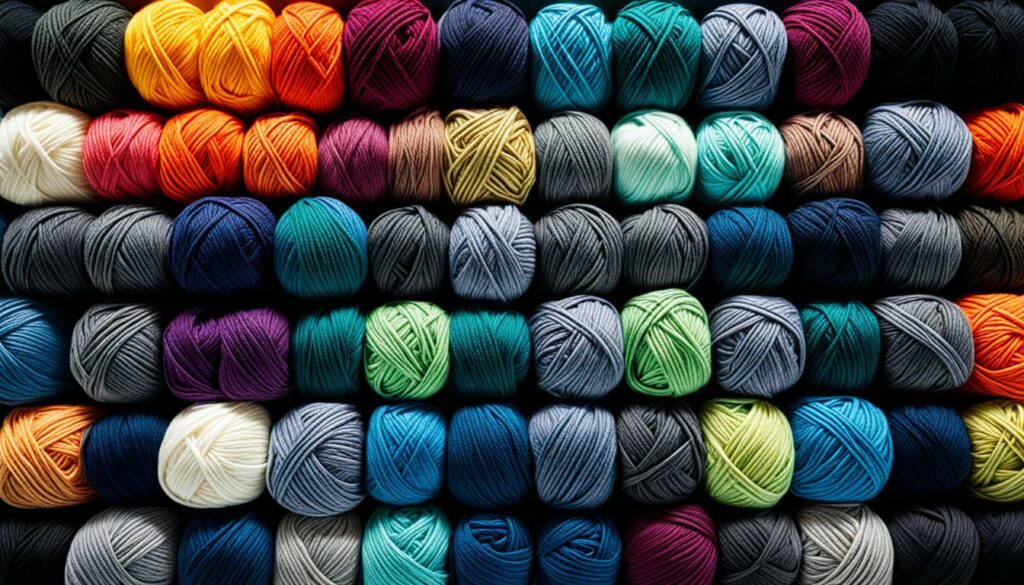
The Quality and Type of Yarn Materials
When it comes to yarn, the quality and type of materials used in its production play a vital role in determining its price. Yarn made from natural fibers like merino wool or cashmere is known for its superior quality and performance, making it a sought-after choice among knitting enthusiasts. These luxury yarns offer unparalleled softness, warmth, and durability, but their premium characteristics come at a higher cost.
In addition to natural fibers, there are also yarns crafted from synthetic fibers. These fibers can mimic the properties of natural materials while offering different benefits, such as increased affordability and washability. Synthetic yarns are often more budget-friendly compared to luxury yarns, making them a popular choice for everyday knitting projects.
Another factor that affects the cost of yarn is the inclusion of yarn blends. Yarn blends are created by combining different fibers, such as natural and synthetic materials, to achieve specific qualities and characteristics. These blends offer a balance of affordability and performance, catering to a wide range of knitting needs.
| Yarn Type | Characteristics | Price Range |
|---|---|---|
| Natural Fibers (e.g., Merino Wool, Cashmere) | Superior softness, warmth, and durability | Higher-end |
| Synthetic Fibers (e.g., Acrylic, Nylon) | Affordable, washable, and versatile | Mid-range |
| Yarn Blends (e.g., Wool/Acrylic Blend) | Combines the qualities of different fibers | Varies based on composition |
“Yarn made from the finest cashmere fibers offers unparalleled softness and luxury, perfect for creating heirloom-quality knitted pieces.”
Additionally, certain specialty yarns, such as hand-dyed or small-batch yarns, are known for their uniqueness and craftsmanship. These yarns are often created by independent artisans who take pride in their work, hand-dyeing yarn in small quantities to produce one-of-a-kind colorways. The artistry and attention to detail in these specialty yarns contribute to their higher price point, but they offer knitters an opportunity to create truly extraordinary projects.
The quality and type of yarn materials influence not only the price but also the overall knitting experience. Depending on your project requirements and budget, you can choose from a wide range of yarn options, from luxurious natural fibers to affordable synthetic blends.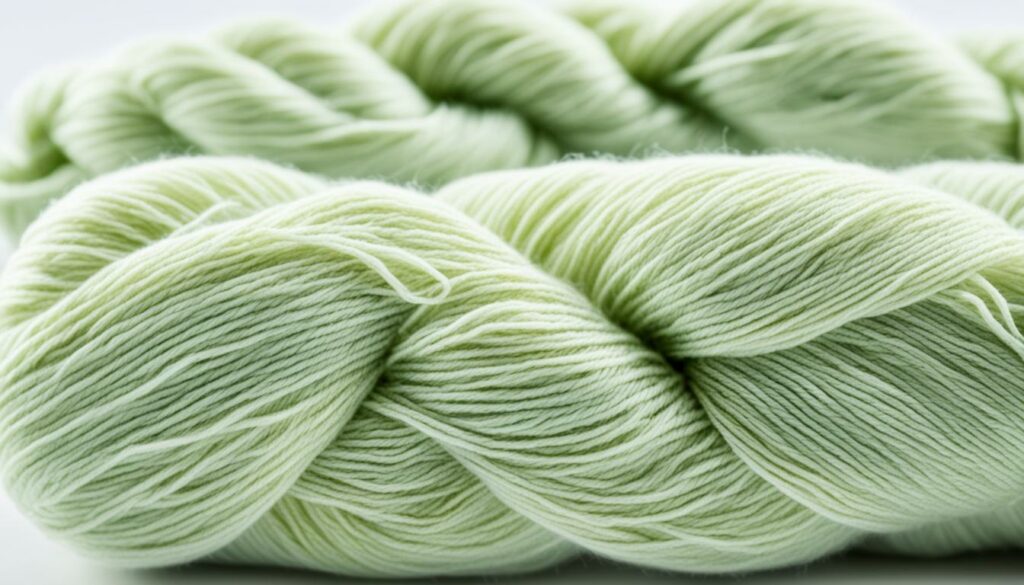
The Influence of Yarn Weight and Thickness
When it comes to yarn, weight and thickness are important factors that can affect its pricing. Yarns are available in various thicknesses, from bulky to fine, each serving different purposes and catering to unique knitting projects. The weight and thickness of yarn impact the amount of material required for production, which in turn influences the price.
Chunky or bulky yarns, such as those used for cozy sweaters or blankets, typically require more material to produce compared to finer yarns. As a result, these thicker yarns may be priced slightly higher due to the increased cost of raw materials and production. This allows manufacturers to account for the additional resources used in creating these bulkier yarns. Despite the higher price, many knitters appreciate the warmth and softness that chunky yarns offer, making them well worth the investment for certain projects.
On the other hand, fine yarns, which are often used for delicate items like lace shawls or lightweight garments, tend to be more affordable. The thinner threads used in finer yarns require less material, reducing the overall cost of production. This makes them a budget-friendly option for projects that require a lighter and more delicate touch.
The Versatility of Worsted Weight Yarn
One popular type of yarn is worsted weight yarn. Worsted weight refers to the medium thickness of the yarn, making it suitable for a wide range of projects. Due to its versatility and popularity, worsted weight yarn can be found at various price points, offering options for knitters with different budgets. Whether you’re creating a cozy sweater or a simple hat, worsted weight yarn provides the ideal balance between thickness and affordability.
The Specialized Appeal of Sock Yarn
Sock yarn is another type of yarn that varies in price due to its unique characteristics and purpose. Sock yarn is specifically designed to create durable and comfortable socks, often incorporating materials like nylon or elastic for added strength and stretch. Due to its specialized nature, sock yarn may be priced slightly higher compared to other types of yarn. The value lies in its durability and ability to withstand constant wear and tear, making it a worthwhile investment for those who love knitting socks.
Overall, the weight and thickness of yarn contribute to its pricing, with bulky yarns usually commanding a higher price and fine yarns offering a more affordable option. Specialized types of yarn, like worsted weight yarn and sock yarn, may also vary in price due to their suitability for particular projects. By understanding the influence of yarn weight and thickness on pricing, knitters can make informed decisions when selecting yarn for their creations.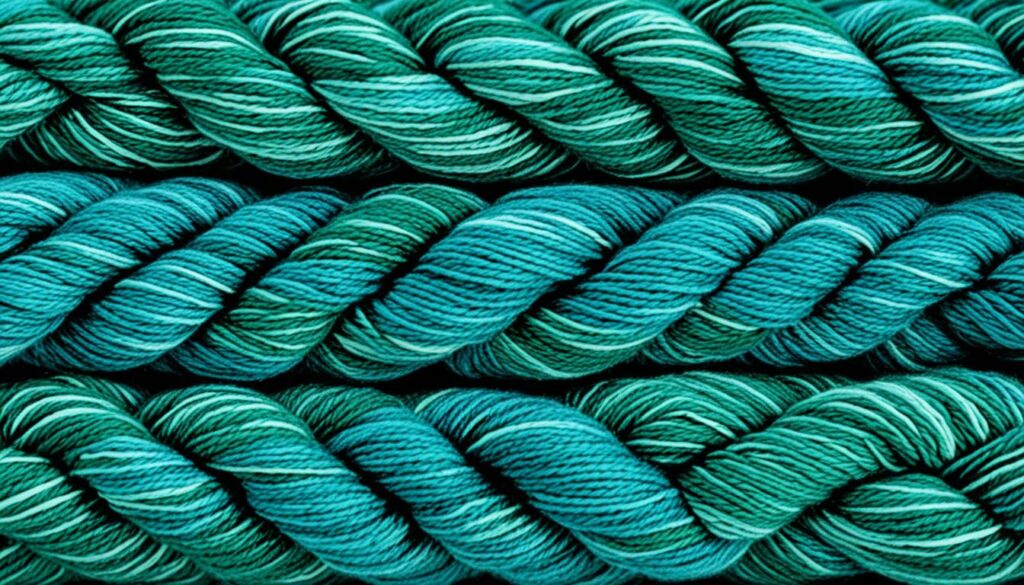
The Overhead Costs of Yarn Shops
When it comes to the cost of yarn, there are various factors at play. One significant aspect is the overhead costs associated with running a yarn shop. These expenses include rent, utilities, employee wages, and other operational costs that are factored into the pricing of yarn.
Running a physical retail store comes with its own set of financial responsibilities. Yarn shops need a physical space to display and store their products, which incurs rental expenses. Additionally, utilities such as electricity, water, and heating/cooling systems contribute to the overall overhead costs.
Employee wages are another aspect of retail overhead costs. Yarn shops typically employ knowledgeable and helpful staff to assist customers with their yarn purchases, provide guidance on projects, and offer knitting advice. Ensuring they have a dedicated and well-trained team requires investment in employee wages.
Furthermore, yarn shops often curate a selection of unique or premium yarns, catering to customers looking for something special or exclusive. These yarns may come with a higher price tag due to their quality, rarity, or craftsmanship, contributing to the retail markup.
So, while it may seem like yarn prices are solely determined by the cost of production and raw materials, it’s important to consider the additional expenses that yarn shops face in order to provide a physical retail experience to customers.
“Running a physical yarn shop involves various overhead costs such as rent, utilities, and employee wages, which are factored into the pricing of yarn.”
Comparing Overhead Costs of Yarn Shops
| Expense | Yarn Shop A | Yarn Shop B | Yarn Shop C |
|---|---|---|---|
| Rent | $2,500/month | $1,800/month | $3,000/month |
| Utilities | $400/month | $350/month | $500/month |
| Employee Wages | $3,000/month | $2,500/month | $3,500/month |
| Total Overhead Costs | $5,900/month | $4,650/month | $7,000/month |
As seen in the table above, different yarn shops may have varying overhead costs depending on factors such as location, size, and the number of staff members. These costs ultimately impact the pricing of the yarn sold in each store.
Understanding the overhead costs of yarn shops gives knitters and consumers insight into why yarn prices may differ between stores. By considering these factors, you can make more informed decisions when selecting yarn and managing your budget for knitting projects.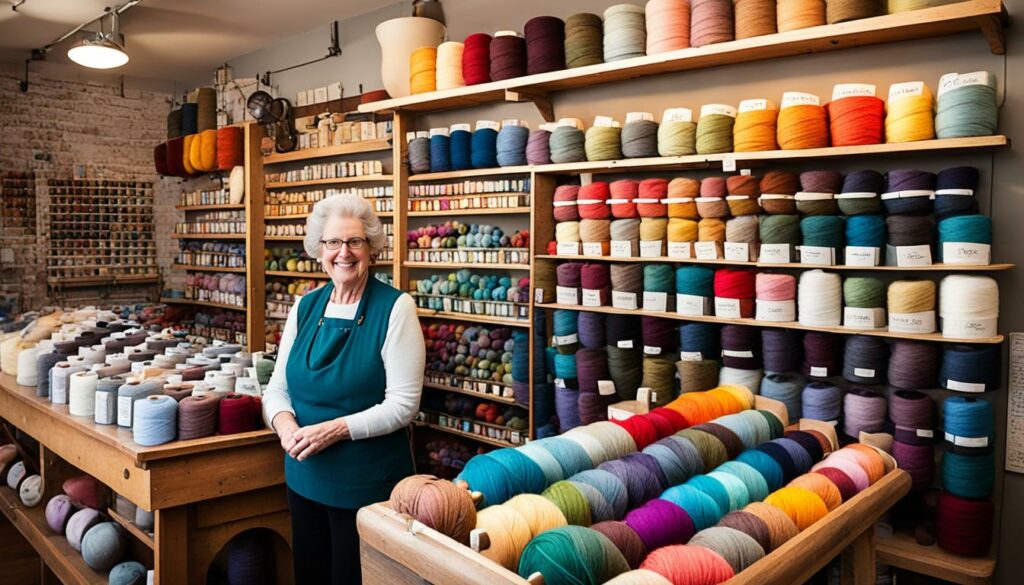
The Rise of Recycled Yarn and Sustainable Practices
In recent years, there has been a growing movement towards repurposing and recycling yarn. More and more knitters are embracing the idea of giving old garments new life by unraveling them and transforming them into beautiful recycled yarn. This sustainable practice not only reduces textile waste but also offers an affordable alternative to purchasing new yarn.
By repurposing old garments, you can obtain recycled yarn that carries a unique story and history. The process of unraveling sweaters and other knitted items allows you to salvage the yarn and give it a second chance. This not only adds a special charm to your knitting projects but also contributes to a more sustainable approach in the yarn industry.
“Recycled yarn is more than just a creative solution to repurposing old garments. It represents a commitment to reducing our environmental impact and promoting sustainability in the yarn industry.”
Repurposing old garments into recycled yarn also helps to address the issue of textile waste. By opting for recycled yarn, you are actively participating in reducing the amount of fabric that ends up in landfills. This small action plays a part in promoting a more sustainable and circular fashion system, where materials are reused and repurposed rather than discarded.
Initiatives like the Unraveling Club have emerged to educate and inspire knitters to embrace recycled materials. This community-driven movement provides resources and support to individuals interested in repurposing old garments to create their own unique yarn. Through the Unraveling Club, knitters can share tips, patterns, and stories of their recycled yarn projects, fostering a sense of camaraderie and a shared commitment to sustainability.
Advantages of Recycled Yarn:
- Reduces textile waste and landfill accumulation
- Offers an affordable and sustainable alternative to purchasing new yarn
- Provides a unique and storied yarn for your projects
- Promotes a circular fashion system that values repurposing and reusing materials
- Contributes to a more environmentally friendly and socially responsible yarn industry
As the demand for sustainable practices continues to grow, recycled yarn is emerging as a viable solution for knitters and the yarn industry as a whole. By repurposing old garments and embracing recycled yarn, you can actively contribute to reducing textile waste while enjoying the creative process and unique qualities that recycled yarn brings to your knitting projects.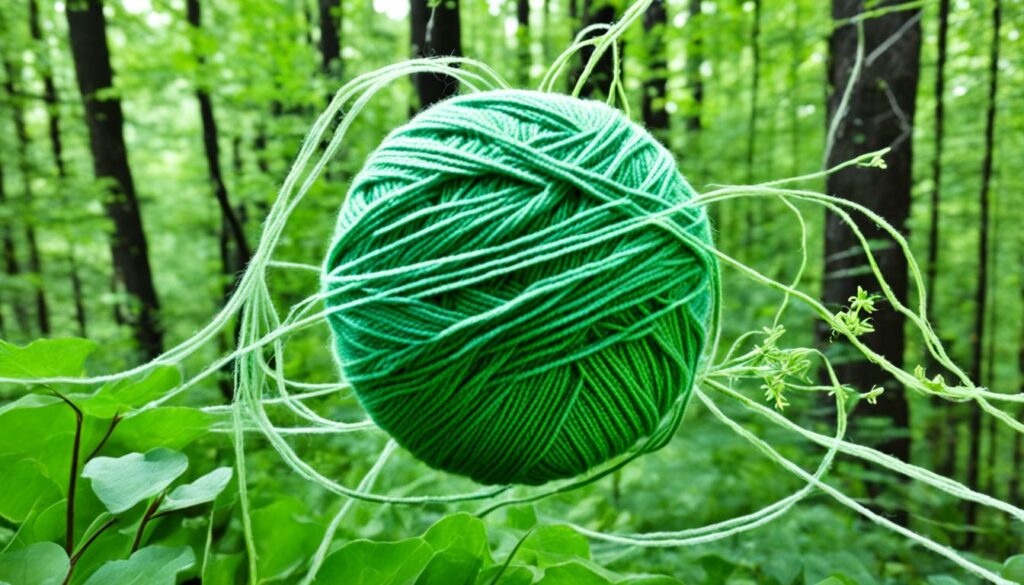
The Value of Hand-Dyed and Specialty Yarns
When it comes to yarn, there is an undeniable allure to hand-dyed and specialty varieties. These unique yarns not only captivate with their vibrant colors and exquisite textures but also carry a higher price tag. Crafted with meticulous care and attention to detail, hand-dyed and specialty yarns offer an unparalleled level of artistry that cannot be replicated.
Each skein tells a story, showcasing the skill and expertise of the artisan behind its creation. The process of hand-dyeing yarn involves carefully applying dyes by hand, resulting in breathtaking colorways that blend and meld in harmonious combinations. This level of artistry brings a sense of awe and wonder, elevating the knitting experience and transforming simple projects into works of art.
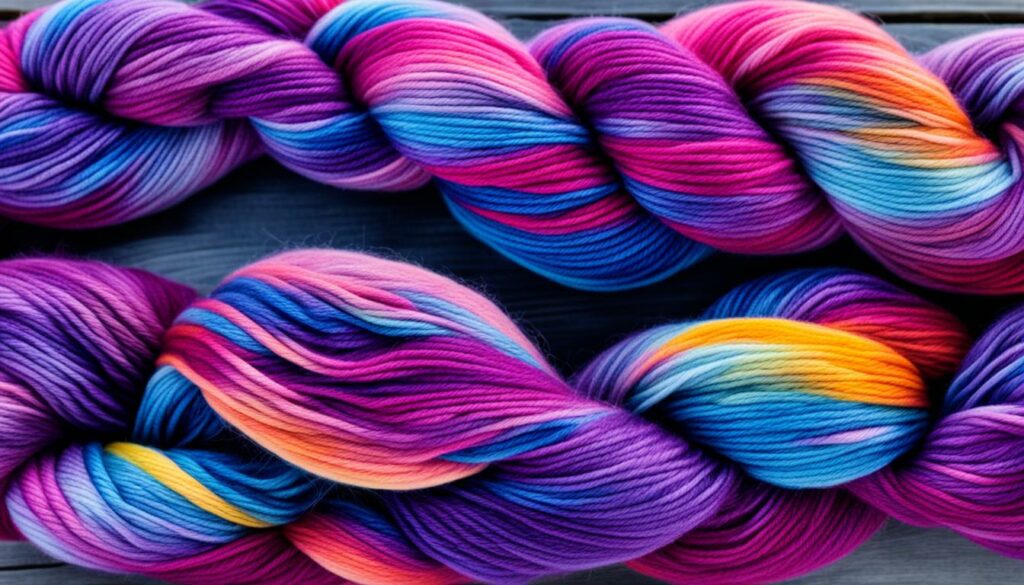
Specialty yarns, on the other hand, go beyond traditional fiber choices and design elements. They encompass a wide range of characteristics, such as luxurious fibers like silk, alpaca, or cashmere, as well as innovative blending techniques that result in unique textures and finishes. These yarns open up a world of possibilities for knitters, offering a chance to create garments and accessories with unparalleled beauty and style.
By investing in hand-dyed and specialty yarns, you not only gain access to a wide array of colors and material options but also support the continued growth and artistry in the yarn industry. These yarns are often produced in small batches, ensuring exclusivity and rarity. Knitting with such yarns enables you to bring your vision to life with a level of sophistication and elegance that sets your projects apart.
The Desirability of Hand-Dyed and Specialty Yarns
Nothing compares to the satisfaction and joy of working with hand-dyed and specialty yarns. The depth of color, the softness of the fibers, and the overall uniqueness of each skein make these yarns irresistible to knitters of all skill levels. They truly evoke a sense of awe and artistry in every stitch.
When you knit with hand-dyed and specialty yarns, you not only create beautiful garments and accessories but also become part of a vibrant and passionate community. These yarns inspire conversations, spark creativity, and foster connections with fellow knitters who share a love for the artistry of yarn production.
Choosing Hand-Dyed and Specialty Yarns
When selecting hand-dyed and specialty yarns, consider the project you have in mind and the effect you want to achieve. Whether you’re creating a statement piece or adding subtle pops of color to your design, these yarns offer a range of options to suit your needs.
Additionally, explore the various bases and materials available. From sumptuously soft merino wool to luxurious blends, each fiber brings its own unique qualities to the finished project. Don’t be afraid to experiment and step outside your comfort zone; that’s where the magic happens.
The Investment in Artistry
Hand-dyed and specialty yarns are more than just materials for knitting—they are investments in the artistry and passion of yarn production. These yarns allow you to create one-of-a-kind pieces that reflect your individuality and style. They turn every project into a canvas, where color and texture blend seamlessly to bring your vision to life.
| Yarn | Description |
|---|---|
| Artisanal Hand-Dyed Yarn | Meticulously hand-dyed by skilled artisans, these yarns feature stunning color combinations and gradients that elevate your projects to new heights. |
| Specialty Blends | Explore the world of luxury fibers and blending techniques with specialty yarns. Cashmere, silk, and alpaca are just a few of the materials that add an extra touch of sophistication to your knitting. |
| Unique Textures | Step into a realm of creativity with yarns that boast unique textures and finishes. From fluffy boucle to smooth and silky, these yarns lend a distinctive touch to your projects. |
Indulging in hand-dyed and specialty yarns is not only a treat for your knitting needles but also a celebration of the passion, skill, and artistry that goes into yarn production. With every stitch, you can appreciate the beauty and uniqueness of these yarns, making each project a masterpiece.
Finding the Balance: Quality and Budget
When it comes to choosing yarn, one of the key considerations is finding the right balance between quality and budget. While there are luxurious yarn options made from premium fibers that can be quite expensive, there are also affordable alternatives that offer good quality for those on a tight budget.
As a knitter or consumer, it is important to assess your project requirements and budget before making a yarn purchase. By considering your specific needs and limitations, you can make a well-informed decision that satisfies both your desire for high-quality yarn and your financial constraints.
Whether you’re working on a large-scale project or a small, intricate design, there are budget-friendly yarn options available that still deliver satisfactory results. Many reputable yarn brands offer cost-effective choices that maintain a good balance between price and quality.
One option for affordable yarn is to explore blends of natural and synthetic fibers. These blends often provide the desired characteristics of higher-end natural fibers at a more accessible price point. They can be a cost-effective alternative that doesn’t compromise on quality.
Another consideration is to look for sales, discounts, or promotions offered by yarn retailers. Often, you can find high-quality yarns at reduced prices during seasonal sales or clearances. These opportunities allow you to shop for the yarn you love without breaking the bank.
A practical strategy for balancing quality and budget is to start with small, less expensive projects. By doing so, you can experiment with different yarns, gain experience, and discover which options work best for you. This approach allows you to gradually invest in pricier yarns as you gain confidence and take on more complex projects.
“Choosing yarn involves finding the right balance between quality and budget.” – Knitting Enthusiast
Quality Tips for Budget-Friendly Yarn:
- Consider yarns with machine washable properties to reduce long-term maintenance costs.
- Look for budget-friendly options in local yarn shops or online marketplaces that offer a wide variety of choices.
- Explore yarns with adequate yardage or meterage, maximizing the value you get for each skein or ball.
- Read reviews and seek recommendations from fellow knitters or community groups to identify affordable yarn options without compromising on quality.
- Keep an eye out for clearance sales or end-of-season discounts to find high-quality yarns at a fraction of their original price.
Remember, finding the perfect yarn for your projects is all about striking the right balance between quality and budget. With a little research, creativity, and awareness of affordable options, you can knit beautiful creations while staying within your financial means.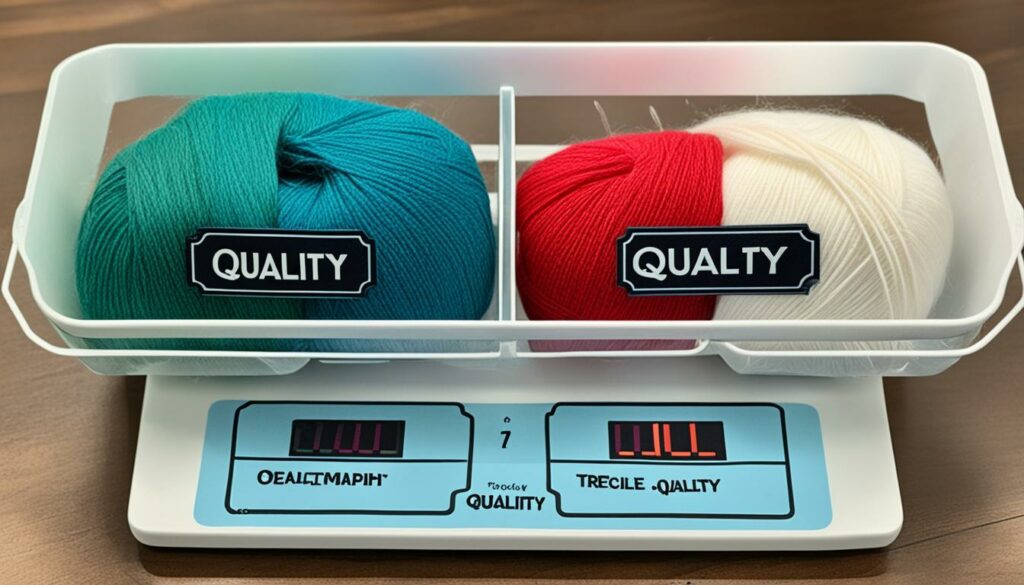
The Future of Sustainable Yarn and Innovative Technologies
The yarn industry is undergoing a transformation to meet the growing demand for sustainability and environmentally friendly practices. Innovations in yarn production methods and materials are revolutionizing the way yarn is made, paving the way for a more sustainable future.
One of the key developments in sustainable yarn production is the rise of recycled yarn. By repurposing old garments and textile waste, yarn manufacturers are reducing the environmental impact of the industry. Recycled yarn not only helps to minimize textile waste but also offers a more cost-effective and eco-friendly alternative for knitters.
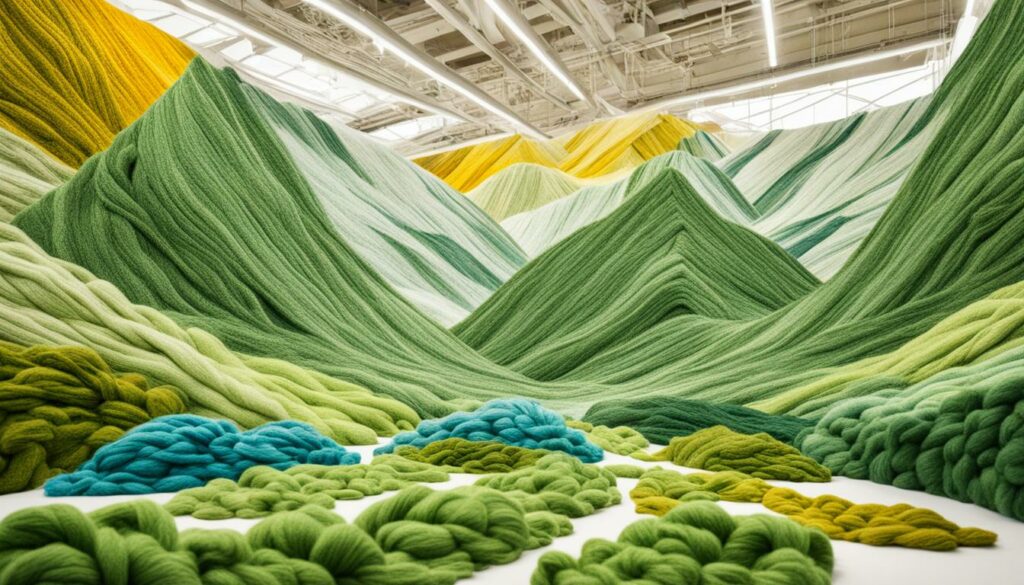
Furthermore, sustainable materials are being used in the production of yarn. Natural fibers like organic cotton, bamboo, and hemp are gaining popularity due to their renewable and environmentally friendly characteristics. These materials require fewer resources, such as water and fertilizers, making them a more sustainable choice for yarn production.
“The yarn industry is embracing sustainable practices to reduce its ecological footprint and create a more responsible supply chain.” – Eco Yarn Co.
In addition to sustainable materials, innovative technologies are playing a vital role in shaping the future of the yarn industry. Automatic knitting machines, for example, offer increased efficiency and reduced waste by precisely controlling yarn consumption. These machines can produce yarn and clothing in a more sustainable and cost-effective manner, benefiting both manufacturers and consumers.
The Benefits of Sustainable Yarn and Innovative Technologies
The adoption of sustainable yarn and innovative technologies brings several benefits to both the industry and consumers. By prioritizing sustainability, the yarn industry can significantly reduce its carbon footprint and contribute to the preservation of natural resources.
- Environmentally friendly yarn production methods help minimize textile waste and reduce the need for virgin materials.
- Sustainable materials offer a renewable alternative to traditional fibers, promoting biodiversity and reducing the use of harmful chemicals.
- Innovative technologies enhance efficiency and reduce waste, leading to cost savings for manufacturers and potentially lower prices for consumers.
- Socially responsible practices foster transparency and accountability within the yarn industry, ensuring fair labor conditions and promoting ethical sourcing.
Embracing sustainability and leveraging innovative technologies in the yarn industry is crucial to meet the evolving demands of environmentally conscious consumers. By making socially responsible choices, yarn manufacturers and consumers can contribute to a greener and more sustainable future.
Conclusion
Understanding the various factors that contribute to the cost of yarn is crucial for making informed choices. Yarn prices are influenced by inflation, supply and demand, the quality of materials, and production methods. By considering these factors, you can navigate the yarn market and find options that align with your budget and project requirements.
Moreover, exploring sustainable yarn practices is not only beneficial for the environment but also supports a socially responsible yarn industry. Embracing recycled yarn and opting for sustainable materials can help reduce textile waste and promote a more sustainable future for the industry. As a knitter or consumer, you have the power to contribute to these positive changes.
So, the next time you embark on a knitting project, remember to consider the yarn pricing factors and explore sustainable options. By doing so, you can enjoy your craft while also supporting a more environmentally friendly and socially responsible yarn industry. Let’s knit with a purpose and make a positive impact.
FAQ
Why does yarn cost so much?
How does inflation impact yarn prices?
What role does supply and demand play in yarn pricing?
How does the quality and type of yarn materials affect pricing?
Does the weight and thickness of yarn affect its pricing?
How do overhead costs of yarn shops impact yarn pricing?
What is the significance of recycled yarn and sustainable practices in the yarn industry?
Why are hand-dyed and specialty yarns more expensive?
How can I find the right balance between quality and budget when choosing yarn?
What does the future hold for sustainable yarn and innovative technologies in the industry?
Why is it important to understand the factors that contribute to the cost of yarn?
Vivienne – Your Content Companion Vivienne is your content companion, curating valuable tips, advice, and inspiration to guide you on your home decor journey. From insightful blog posts to informative product descriptions, she’s here to empower you with the knowledge you need to create your dream space.
Yarn
Discover How It Can Be Spun Into Fine Yarn
Uncover the craft of turning fibers that can be spun into fine yarn. Dive into the art of yarn spinning and master this timeless technique.
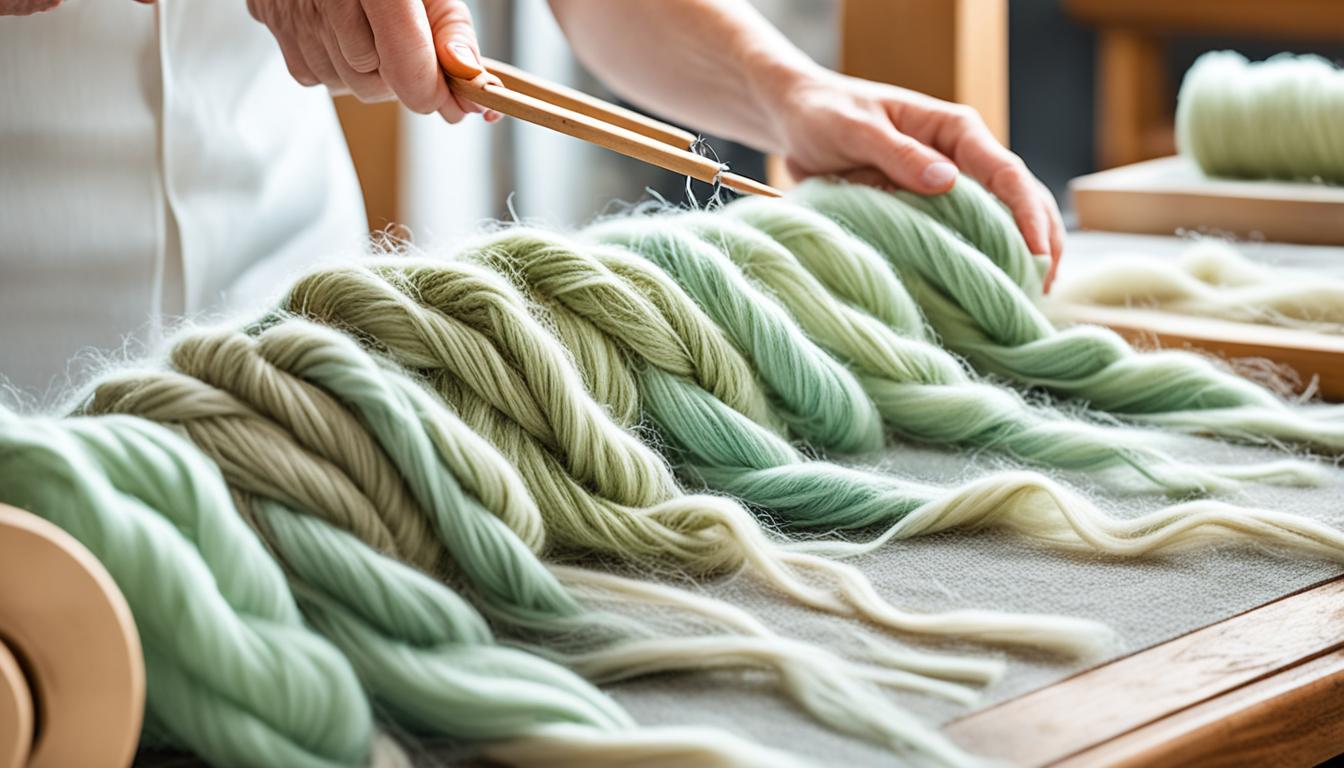
Have you ever thought about how regular fibers can be turned into gorgeous, textured yarns? It’s time to discover the mysteries of core spinning! This special method enables you to make creative and expressive yarns that are brimming with charm and individuality.
Core spinning involves wrapping fibers around a core thread, resulting in a yarn with a distinctive texture. But how does it work, and what materials are best for core spinning? Let’s dive into the fascinating world of yarn spinning and discover the endless possibilities.
Key Takeaways:
- Core spinning is a method used to create wild and textured yarns.
- Choose a strong core thread to handle tension and twist.
- Spinning wheels with larger orifices and slow pulleys are ideal for core spinning.
- Experiment with different fibers and embellishments to create unique textures.
- Core spinning offers endless possibilities for handmade yarn with wild texture.
Choosing the Right Core Thread
When it comes to core spinning, one of the key factors to consider is choosing the right core thread. The core thread plays a crucial role in the spinning process as it is responsible for transferring the twist in the yarn. This means that the core thread experiences a significant amount of stress, especially when creating heavily textured yarns.
To ensure that your core thread can handle the tension and twist without breaking, it is recommended to use strong core threads such as crochet cotton, loop mohair, or brushed mohair. These materials have proven to be reliable choices for core spinning due to their durability and flexibility.
Some spinners follow a specific technique of adding the twist in one direction to the core thread and then core spinning in the opposite direction to balance the twist. However, it is important to note that achieving a perfectly balanced core thread is not necessary when core spinning. With practice and experience, the core-spun yarns will naturally become more balanced.
By selecting the right core thread and understanding the spinning techniques involved, you can create beautiful and textured core-spun yarns that showcase the uniqueness of core spinning.
Here is a table comparing different core threads for core spinning:
| Core Thread | Strength | Flexibility |
|---|---|---|
| Crochet Cotton | High | Medium |
| Loop Mohair | Medium | High |
| Brushed Mohair | Medium | Medium |
Wheel Adjustments for Core Spinning
Core spinning, a technique used to create unique and textured yarns, can be done on either a spinning wheel or a spindle. However, using a spinning wheel is often more convenient, especially when aiming to produce smoother and finer core-spun yarns. Modern spinning wheels are designed to handle larger-gauge or textured yarns, making them ideal for core spinning.
When selecting a spinning wheel for core spinning, look for key features that facilitate the process. Wheels with a larger orifice provide ample space for the core thread and wrapping fibers to pass through smoothly. Additionally, ensure that the hooks or pegs on the wheel won’t snag the fibers, as this can lead to issues during spinning.
Another important consideration is the wheel’s pulley system. Opt for spinning wheels with slow pulleys, as they allow for better control over the spinning process, especially for beginners. It is recommended to use the slowest ratio on the spinning wheel, preferably a ratio of 6:1 or lower, to prevent excess twist in the core thread.
As spinners gain more experience and become comfortable with core spinning, they may find that slightly higher speeds work better for their specific technique and desired yarn outcome.
By making the necessary wheel adjustments for core spinning, spinners can enjoy a smoother and more enjoyable spinning experience while creating beautiful core-spun yarns.
Key Wheel Features for Core Spinning
| Wheel Feature | Importance |
|---|---|
| Larger Orifice | Allows for smooth passage of core thread and wrapping fibers. |
| Non-Snagging Hooks/Pegs | Prevents fibers from getting caught or damaged during the spinning process. |
| Slow Pulleys | Offers better control over the spinning process. |
| Low Ratio (6:1 or lower) | Prevents excess twist in the core thread. |
With these wheel adjustments in mind, spinners can fully unlock the potential of core spinning and create stunning core-spun yarns.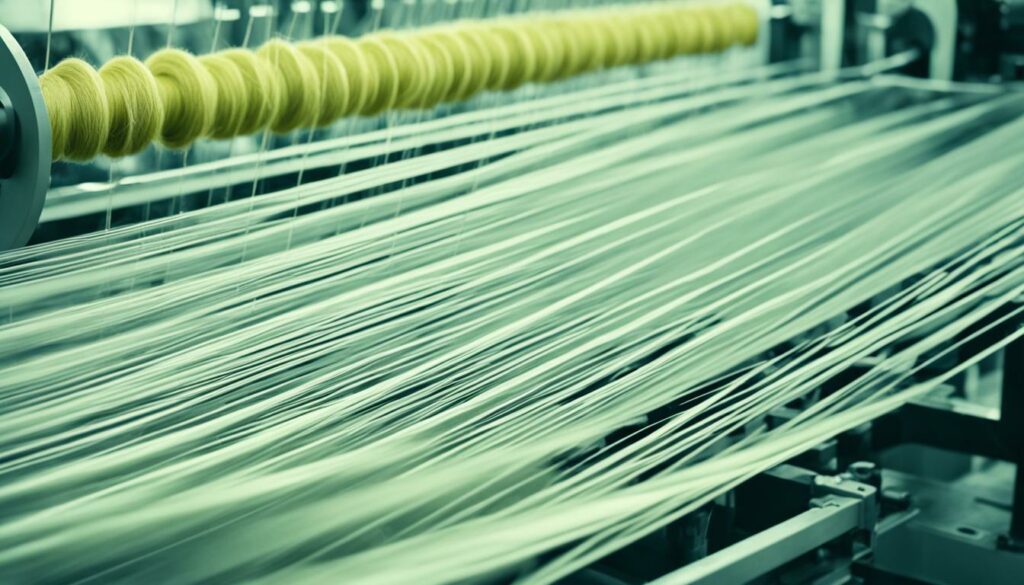
Types of Spinning Tension
When it comes to spinning tension, there are two types of spinners: “givers” and “takers”.
Givers prefer to spin a length of yarn and “give” it to the wheel, feeding the bobbin with long lengths of yarn. Takers, on the other hand, like to feel the wheel pull the yarn into the orifice while spinning, continually feeding yarn into the bobbin.
“Givers” and “takers” have different approaches to the take-up tension in their spinning process.
For core spinning, givers may need to increase tension to accommodate bulkier yarns. This ensures that the yarn is pulled through the orifice at a steady pace, allowing them to create the desired texture in the core-spun yarn.
On the other hand, takers may need to decrease tension to allow more time for wrapping the fiber around the core. This allows them to have better control over the wrapping process, resulting in a more even distribution of the fiber around the core thread.
It’s important to find the right balance of tension that works for you and your spinning technique. The tension should gently pull the yarn through the orifice, neither too loose nor too tight, at a speed that allows you to work comfortably and create the desired yarn characteristics.
Experiment with different levels of tension to find what works best for you. Remember to adjust the tension based on the thickness and texture of the yarn you’re creating.
| Givers | Takers |
|---|---|
| Prefer to spin a length of yarn and “give” it to the wheel | Like to feel the wheel pull the yarn into the orifice while spinning |
| Feed the bobbin with long lengths of yarn | Continually feed yarn into the bobbin |
| May need to increase tension for core spinning bulky yarns | May need to decrease tension for better control over wrapping |
Tips for Fine-Tuning Wild Texture
Core spinning is a versatile technique that allows you to create a wide range of textures and structures in your handspun yarn. If you’re looking to add some truly wild texture to your yarn, here are some tips to help you fine-tune your core spinning:
Create Sculptural Wires
If you want to add unique forms and shapes to your yarn, consider using wire as your core thread. Beading wire and floral wire are excellent choices for creating sculptural textures in your yarn. The malleability of the wire allows you to shape it in various ways, resulting in stunning and unconventional yarn designs.
Add Elastic for Ruffles
When you want to create ruffles and textured elements in your scarves or cowls, using an elastic core thread is a great option. The elasticity of the thread allows your finished piece to stretch and retain its shape, giving it a playful and dynamic look.
Enhance with Surface Thread Wraps
To secure wild textures, such as locks, and add visual appeal to your core-spun yarn, consider adding a surface thread wrap. You can use different types of threads for the wrap, such as contrasting colors or textured threads, to achieve the desired effect. The surface thread wrap not only adds dimension to your yarn but also helps hold the wild texture in place.
“Core spinning offers endless possibilities for creating unique textures and structures in your handspun yarn.”
With these tips, you can take your core spinning to the next level and create yarns with truly wild and exciting textures. Don’t be afraid to experiment and push the boundaries of traditional spinning techniques. Embrace the freedom core spinning provides and let your creativity soar.
| Embellishments | Description |
|---|---|
| Sculptural Wires | Creates unique forms and shapes in the yarn using wire as the core thread. |
| Elastic | Enhances ruffles and textured elements in scarves and cowls. |
| Surface Thread Wraps | Adds visual appeal and secures wild texture in the core-spun yarn. |
Troubleshooting Core Spinning Issues
Core spinning is a fascinating technique for creating unique and textured yarns. However, like any skill, it comes with its challenges. In this section, we will explore common problems encountered during core spinning and provide you with solutions to overcome them.
1. Too Much Twist
If you find that your core-spun yarn has excessive twist, which can result in a tightly spun and hard-to-work yarn, there are a few adjustments you can make. Firstly, try using the slowest ratio on your spinning wheel and treadling slower. This will help reduce the amount of twist being added to your yarn. Additionally, you can experiment with different drafting techniques to control the amount of twist transferred to the core, such as long draw or short forward draw.
2. Too Little Twist
On the other hand, if you’re experiencing a lack of twist in your core-spun yarn, resulting in loose fibers that are prone to unraveling, adjusting the wheel to a faster ratio can help. Increasing the speed of your wheel will add more twist to the yarn as it forms. Remember to practice slowly at first and gradually increase your speed until you achieve the desired twist in your yarn.
3. Take-Up Problems
Sometimes, you may encounter issues with the take-up of the yarn onto your bobbin. If your yarn is not winding onto the bobbin smoothly or is not being taken up at all, it’s crucial to address this problem. One possible solution is to add more tension to the yarn by adjusting the tensioning mechanism on your spinning wheel. Another possible culprit could be the flyer guides. Check for any obstructions or buildup that may be impeding the smooth flow of yarn and clean them if necessary.
4. Orifice Problems
If you specialize in creating bulky core-spun yarns using thick and textured fibers, you may encounter orifice problems. A narrow orifice may not be able to accommodate these bulkier textures, leading to frustration and difficulties in spinning. In such cases, consider using a spinning wheel with a larger orifice to accommodate the size of the fibers you’re working with. This will allow for smoother and more effortless spinning of your desired yarn.
5. Spinning Slippery Locks
Working with slippery locks, such as mohair or silk, can present its own set of challenges due to their smooth and lustrous nature. Spinning these locks while they are slightly damp can provide better control and grip, making the process easier. The moisture adds some friction, allowing the fibers to hold onto the core thread more effectively. Remember not to oversaturate the locks, as too much moisture can impact the overall quality of your spun yarn.
By troubleshooting these core spinning issues, you can enhance your spinning experience and create beautiful, textured yarns with confidence. Keep practicing and experimenting, and soon you’ll be able to overcome any challenges that come your way!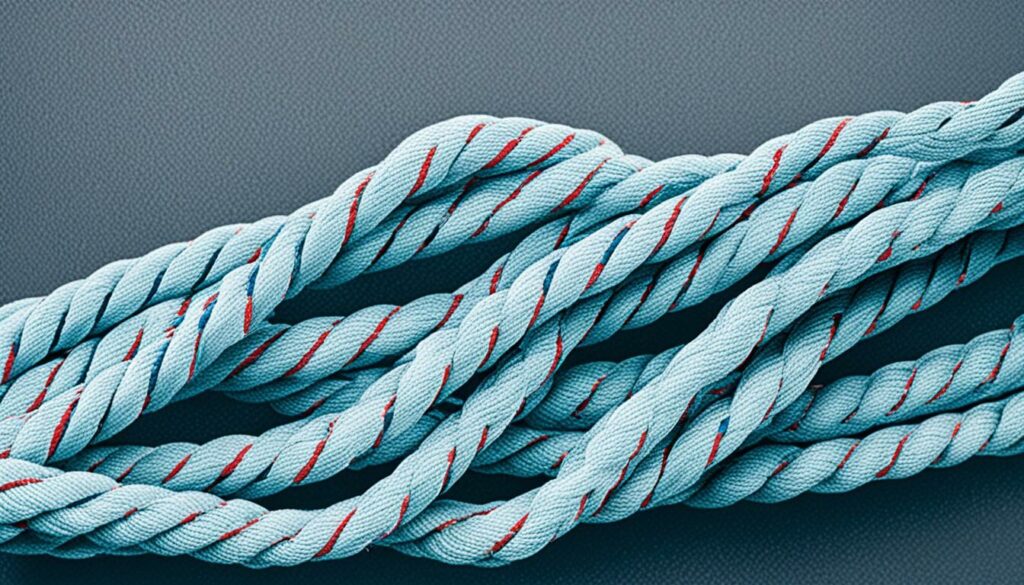
Core Spinning Art Batts
Art batts are a versatile and exciting option for core spinning, allowing you to create unique and textured yarns that are bursting with personality. These prepared fiber blends are specifically designed for core spinning and offer endless possibilities for creativity. With art batts, you can explore different colors, fibers, and textures to achieve the exact yarn you envision.
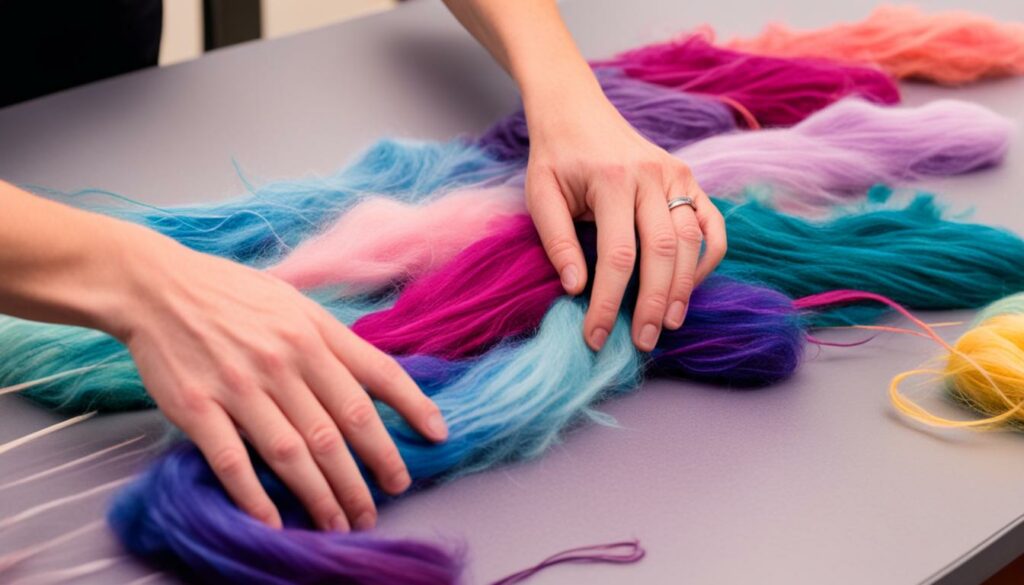
When core spinning art batts, start by inserting the core thread into a bobbin leader with a loop. This loop will help secure the fiber onto the core thread. With the fluffy end of the predrafted fiber held at a 90-degree angle to the core, begin treadling slowly. As you treadle, allow the fiber to catch onto the thread and wrap around it, creating a beautiful and textured yarn. The thickness of the resulting yarn can be controlled by adjusting the amount of fiber wrapped around the core.
Once you have finished core spinning your art batts, you have a few options for finishing. You can wash the yarn to set the twist, or you can choose to steam it. This will help the yarn to relax and solidify, ensuring that all the fibers are secured in place. The finished yarn will have a delightful texture and a unique appearance that is sure to impress.
Harness the potential of art batts in your core spinning journey and unlock a whole new world of creativity. These fiber blends are specifically crafted to inspire and empower you to create yarns that are as individual as you are.
Core Spinning Locks
Locks, which are individual sections of fiber, can be core spun to create textured yarns. The locks are held at a 90-degree angle to the core thread and begin wrapping around it as you treadle slowly. Use your index finger to smooth, support, and control the fiber as it wraps. Mohair core thread works well for spinning wool locks because the fuzzy texture of the mohair allows the locks to grab onto it easily. The amount of picking done on the locks will determine the level of texture in the finished yarn.
For a complete guide on how to core spin locks, refer to the table below:
| Step | Action |
|---|---|
| 1 | Prepare your materials: locks, core thread (such as mohair), spinning wheel or spindle. |
| 2 | Hold the lock at a 90-degree angle to the core thread. |
| 3 | Begin treadling slowly while allowing the lock to wrap around the core thread. |
| 4 | Use your index finger to smooth, support, and control the fiber as it wraps. |
| 5 | Continue treadling and wrapping until the desired amount of locks is included in the yarn. |
| 6 | Finish the yarn by plying or securing the ends. |
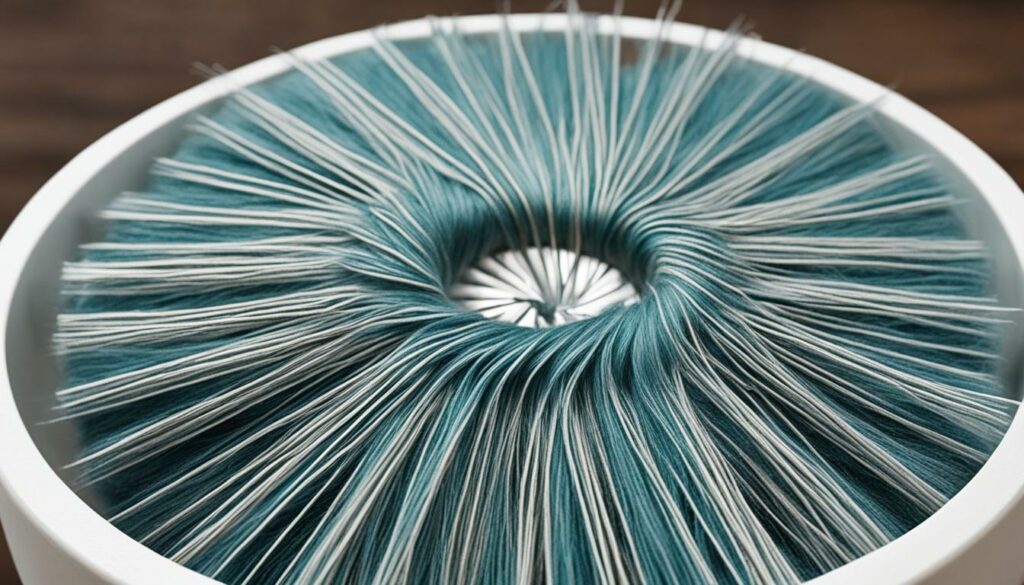
With this technique, you can create yarns with unique texture and visual interest by incorporating locks into your core-spun yarn. Experiment with different breeds and colors of locks to add depth and character to your handspun creations.
Spinning Fine Yarn on Spindles
If you’re a beginner looking to try your hand at spinning fine yarn, spindles are a cost-effective option that allows you to explore this craft. When spinning fine yarn, the thickness of the drafting triangle plays a crucial role in achieving the desired fineness. A thinner drafting triangle enables finer spinning and allows for greater control over the yarn.
To determine the limits and length of the drafting triangle, it’s important to have an understanding of the staple length of the fiber you’re working with. This knowledge helps you adjust your spinning technique accordingly, ensuring optimal results. When aiming for a fine yarn, well-prepared fiber such as roving or top is recommended.
There are different fiber preparations that impact the texture of the yarn. If you’re looking to create a puffy yarn, woolen preparations like roving or rolags are suitable choices. These preparations result in a yarn with added loft and puffiness. On the other hand, if you prefer a smoother yarn, top or combing the fiber aligns the individual fibers, resulting in a more even and silky yarn.
The weight of the fiber can also affect the spinning process when using a spindle. To optimize your spinning experience, it’s often suggested to work with shorter lengths of fiber. This allows for better control and reduces strain during the spinning process, ensuring a more enjoyable and fulfilling experience.
| Advantages of Spinning Fine Yarn on Spindles | Considerations |
|---|---|
| Cost-effective option for beginners | Requires practice to achieve consistent fineness |
| Portable and easy to transport | May have limitations in producing very fine yarns |
| Allows for greater control over drafting and twist | Requires more time and effort compared to spinning wheels |
| Opportunity to develop a deeper understanding of the spinning process | May require additional tools and accessories |
Spindles offer a unique and hands-on approach to spinning fine yarn. They provide a gateway for beginners to delve into the world of spinning and explore the intricacies of fiber crimp and drafting. With practice and perseverance, you’ll soon master the art of spinning fine yarn on a spindle, creating beautiful, handmade yarn that reflects your creativity and dedication.
Plying Fine Yarn
Once you have finely spun singles yarn, it’s time to ply it using various techniques to add depth and texture to your yarn creations. Two-ply yarn and Navajo plying are two common methods that yield beautiful results. Let’s explore each technique in detail.
Two-Ply Yarn
Two-ply yarn is created by twisting two independently spun bobbins together in the opposite direction from which they were spun. This process not only strengthens the yarn but also creates mingling colors and visual interest. To achieve a balanced two-ply yarn, make sure to maintain consistent tension while plying.
Tip: Experimenting with different color combinations in your two-ply yarn can create stunning effects in your finished projects.
Navajo Plying
Navajo plying, also known as chain plying, is a technique often used when there is only one bobbin or when wishing to preserve long color changes. This method involves creating giant crocheted chains from one strand of spun yarn and then plying it to create a thicker yarn. Navajo plying allows for greater control over color changes and results in a yarn with distinct striping or color blocking.
Pro tip: You can use Navajo plying to create stunning gradient yarns by carefully selecting and transitioning between different colors in your chain.
Both two-ply yarn and Navajo plying offer endless possibilities for exploring creativity and designing unique yarns. Whether you prefer the mingling colors of two-ply or the controlled color changes of Navajo plying, these techniques will elevate your yarn spinning to the next level of artistry.
Now that you have learned about plying fine yarn, it’s time to experiment with these techniques and see what beautiful creations you can produce!
| Technique | Description |
|---|---|
| Two-Ply Yarn | Twisting two independently spun bobbins together in the opposite direction to create a balanced yarn with mingling colors. |
| Navajo Plying | Creating giant crocheted chains from one strand of yarn and then plying it to create a thicker yarn with controlled color changes. |
Conclusion
Congratulations on completing this guide to spinning yarn! By mastering spinning techniques, you have unlocked the ability to create beautiful and unique handmade yarn. Whether you use a spinning wheel or a spindle, the possibilities are endless.
With each spin, you will become more proficient, and your confidence will grow. Remember to experiment with different fibers, textures, and techniques to truly make your yarn one-of-a-kind. As you continue on your spinning journey, don’t be afraid to push your boundaries and explore new ideas.
So, what are you waiting for? Grab your wheel or spindle and let your creativity soar. Get lost in the meditative rhythm of spinning, and watch as your handmade yarn takes shape. Whether you spin for relaxation, creative expression, or to create art, spinning yarn is a craft that will bring you joy for years to come.FAQ
Can any material be spun into fine yarn?
What is the core spinning process?
How do I choose the right core thread for core spinning?
Can I use a spinning wheel for core spinning?
How do I adjust the spinning wheel for core spinning?
What are the different types of spinning tension?
How can I add texture to my core-spun yarn?
What can I do to troubleshoot core spinning issues?
How do I core spin art batts?
How do I core spin locks?
Can I spin fine yarn using spindles?
How do I ply fine yarn?
Is spinning my own yarn a rewarding craft?
Vivienne – Your Content Companion Vivienne is your content companion, curating valuable tips, advice, and inspiration to guide you on your home decor journey. From insightful blog posts to informative product descriptions, she’s here to empower you with the knowledge you need to create your dream space.
-

 Vetted7 months ago
Vetted7 months ago15 Best EMS Foot Massagers for Neuropathy to Soothe Your Feet
-
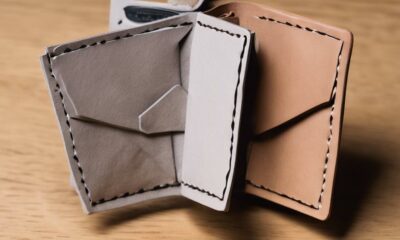
 Vetted7 months ago
Vetted7 months ago14 Best Personalized Father's Day Gifts for Your Husband – Show Him You Care
-

 Alfresco6 months ago
Alfresco6 months agoAlfresco Stacker Doors: Seamless Indoor-Outdoor Living!
-

 Tableware and Dining Accessories6 days ago
Tableware and Dining Accessories6 days agoWhat Is the Meaning of the Word Tableware
-

 Tableware and Dining Accessories6 days ago
Tableware and Dining Accessories6 days agoWhen Is Tableware on Sale at Hobby Lobby
-

 Tableware and Dining Accessories6 days ago
Tableware and Dining Accessories6 days agoWhich of the Following Is Not Classified as Tableware
-

 Craft and Textiles8 months ago
Craft and Textiles8 months ago15 Best Places to Buy Appliances for Your Home – Top Retailers Reviewed
-
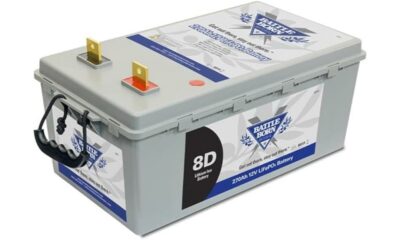
 Vetted6 months ago
Vetted6 months agoBattle Born Batteries Review: Reliable Power Solution




